Monday May 31, 2010
Review: “Restrepo” (2010)
WARNING: SPOILERS
“Restrepo” is the best thing I’ve seen or read about our presence in Afghanistan, and it’s not really about our presence in Afghanistan. It’s about, as the tagline says, one platoon, in one valley, for one year. It goes deep into these soldiers’ lives without telling us much about their actual lives (where they’re from, why they signed up, etc.). It’s an emotional movie precisely because its emotions are restrained. It’s artistic without being artistic. It’s artistic in the Dedalean sense. It doesn’t inspire kinetic emotions but static emotions. The mind is arrested. In this sense maybe Afghanistan itself is artistic. Our mind has been arrested there for almost 10 years.
The directors, author Sebastian Junger (“The Perfect Storm”; “War”) and documentarian Timothy Hetherington (“Liberia: An Uncivil War”), were embedded with Second Platoon, Battle Company, 173rd US Airborne, for parts of a year, from May 2007 to July 2008, and an early scene lets us know just how embedded they were. We’re inside a HUMVEE on patrol when an IED goes off, rocking the vehicle. The men stumble out, including the camera, which is our point-of-view. It’s still filming, shakily, while the men engage in a firefight, but it’s crackling, and there’s no sound. You think of war scenes where a soldier gets shelled and the sound goes out because he’s deafened or in shock. Same here. Our equipment is us.
What Restrepo means
 We first see the men of Second Platoon goofing around and trash talking aboard a train before deployment. Then they ride Chinook helicopters into the dangerous Korengal valley, a beautifully mountainous but militarily indefensible region that stretches six miles along the Afghanistan-Pakistan border, and the trash talking stops. In post-deployment interviews, they fess up to their initial thoughts. Specialist Sterling Jones: “What are we doing?” Sgt. Aron Hijar: “We are not ready for this.” Specialist Miguel Cortez: “I’m going to die here.”
We first see the men of Second Platoon goofing around and trash talking aboard a train before deployment. Then they ride Chinook helicopters into the dangerous Korengal valley, a beautifully mountainous but militarily indefensible region that stretches six miles along the Afghanistan-Pakistan border, and the trash talking stops. In post-deployment interviews, they fess up to their initial thoughts. Specialist Sterling Jones: “What are we doing?” Sgt. Aron Hijar: “We are not ready for this.” Specialist Miguel Cortez: “I’m going to die here.”
Sgt. Joshua McDonough tells the camera, “They’re gathering intel on how to deal with us,” and you think he’s talking about the Taliban, who are trying to kill them, but he’s actually talking about the post-deployment medical personnel in Italy, who are trying to help them. This confusion, this thin line, is what the soldiers deal with every day. Who among the villagers is trying to help? Who is trying to hurt? How do you tell?
The doc keeps doing this. The thing you think we’re talking about isn’t the thing we’re talking about. Information is slowly widened. Clarity, if it comes, comes by and by.
Take the title. “Restrepo”? What the hell's that? Then on that pre-deployment train we discover that the biggest trash talker with the biggest smile is a guy named Juan S. “Doc” Restrepo. “Oh,” we think. “So Restrepo’s a guy. This is a documentary about a guy.” A few minutes later, we find out Restrepo was killed a month into deployment. “Oh,” we think. “So this is a doc about how these guys deal with the loss of this guy.” Then the company moves deeper into the Korengal valley, establish an outpost there, and name it Restrepo, O.P. Restrepo, in honor of their fallen friend. “Oh,” we think. “So this is... Well, this is about all of it, isn’t it?” Our information is slowly widened. Clarity comes by and by.
O.P. Restrepo is deeper into the Korengal Valley than the U.S. has ever pushed before, and four or five times a day, for weeks and months, Second Platoon engages in firefights with the unseen Taliban in the woods. “They’d ambush us from 360 degrees,” Specialist Bemble Pelkin says. “I felt like a fish in a barrel,” Capt. Dan Kearney says. When there are no firefights, there’s digging and fortifying the outpost; and when there’s no digging and fortifying, there’s goofing around to relieve the boredom. Pemble draws and writes. Specialist Angel Toves plays guitar. The men wrestle, or get newbies to wrestle, or goof around with the ‘80s song “Touch Me (I Want to Feel Your Body).” They show off photos of their kids. They hit golf balls into the valley.
The incident with the cow starts out as a joke. A daily briefing, a smile, “we’ll talk about the cow incident later,” laughter from the men. It’s a funny thing. Later, a soldier talks up the day they got fresh cow to eat, saying, “That was a good day.” Later still, three Afghani village elders, with their long beards and taut skin over high cheekbones. enter O.P. Restropo, and it’s seen as a positive step. Hearts and minds are being won. But the elders have come about the cow. It was one of theirs and they want to be repaid. Now it’s a serious thing. The soldiers are apologetic—it got caught in the wire, it had to be killed (then eaten)—but the elders want US$400, which the U.S. higher-ups refuse to give. We’re spending billions on wars but we can’t get US$400 to replace a cow. Instead the owner gets the equivalent in rations: rice and beans. The elders leave. Are we being too tough? Not tough enough? Our information is widened but not enough. Clarity doesn’t come.
This hearts and minds struggle is fascinating to watch. We see Capt. Kearney, with the best of intentions, having regular sitdowns, or shura, with the village elders, but there’s something Business 101 about him. Support us, he tells the elders, and we’ll “make you guys richer.” What about the killing of civilians? the elders want to know. The Captain says it’s all in the past, on another captain’s watch, and insists that everyone needs to put the past behind them. Does this translate? In a later meeting, frustrated beyond measure, he says to the elders, “You are not understanding that I don’t fucking care.” Is this translated? With all of the specialists we have, one wonders why we have no diplomatic specialists. Why aren’t diplomats embedded with soldiers? Why don’t our head honchos speak rudiments of the language? Why, in the soldiers’ down time, don’t they learn rudiments of the language? Why aren’t we adapting?
Three faces
“Restrepo” is never not fascinating, which is odd, because we know answers to most of the questions that traditionally drive storytelling. We know who survives (anyone interviewed post-deployment), and we know O.P. Restrepo won’t be the turning point of the war (we’re in 2010 and we read the newspaper), so what keeps us glued to our seats? I think the short answer is we begin to care. And we want to know what happens to these people we begin to care about.
Why do we begin to care? John Ford once said the most interesting thing in the world to film is the human face, and that’s what Hetherington and Junger keep filming. Three faces stand out.
First, there’s Pemble, who’s got a calm, bemused way about him, like he’s holding onto an inner joke, and who’s a warning to every parent who thinks restricted access will diminish lifelong interest. His mom, he tells us, “was a fucking hippy” (he says it nicely) who didn’t allow him toy guns, or violent movies, or violent video games. And yet here he is—a soldier in Afghanistan. To mom’s credit, he seems the least likely of soldiers. There’s little that’s gung ho about him. He feels like he should be in a punk bar somewhere.
Then there’s Hijar, who’s got huge, tattooed arms in the footage, and an intense, haunted face in the post-deployment interviews. He and the others are talking about Operation Rock Avalanche, a three-day tactical walk-though in a Taliban stronghold, which all agree was the toughest part of the deployment. During the operation, Staff Sergeant Kevin Rice was injured and Staff Sergeant Larry Rougle, generally considered the platoon’s best soldier, was killed, and trying to describe it all, Hijar disconnects. His eyes get lost and he stops talking, and after 10 seconds of silence he looks at the cameraman: “Timeout, alright?” Later he talks about needing a different way to process everything that’s happened. He doesn’t want to forget it, he says; he just needs to process it differently.
Finally, there’s Cortez, who’s smiling, always smiling in the post-deployment interviews. One wonders: “Why is this dude smiling?” Then you realize there’s a disconnect between the look on his face and what he’s saying. Near the end, he talks about how he can’t sleep.
I’ve been on four or five different types of sleeping pills and none of them help. That’s how bad the nightmares are. I prefer not to sleep, and not dream about it, than sleep and see the pictures in my head. It’s...pretty bad.
The smile never leaves his face.
“Restrepo” should get nominated for an Academy Award for best documentary feature, and, unless it’s a helluva year, it should win. It’s already got my early vote for one of the best films of the year. There’s not a false moment in it, not a dull moment in it, and in a serious country it would be released into over 4,000 theaters and everyone would see it. But we’re not a serious country. We haven’t been a serious country for decades. A Roman helmet is painted on a wall at O.P. Restrepo, because it’s cool, I suppose, to remind the men of gladiators, I suppose, but it merely reminded me of the fall of the Roman empire, of the fall of all empires, and it made me wonder where we are in that fall.
“Restrepo” won the Grand Jury Prize at the 2010 Sundance Film Festival and played the Seattle International Film Festival in May. It will get a wider release June 25. It's re-scheduled for Seattle on July 2.
Sunday May 30, 2010
Hollywood B.O.: Ladies Second
Two years ago "Sex and the City" made $59 million during its three-day opening weekend: $26M+ and $17M+ and $12M+. This year, "Sex and the City 2" is estimated to make $46 million over its four-day opening weekend (Thurs.-Sun.): $14M, $13M, $10M., $9M. Adjust for inflation and it's even worse: $63M for three days vs. $46M for four. Take out Thursday's total for "2" and its opening weekend is about half of what "1"'s was.
Now it could be that the fashionistas are waiting until Monday to celebrate Memorial Day with the Four Horsewomen of the Apocalypse. But I doubt it. So why the comedown?
Last week I argued the latest "Shrek" faltered because the previous "Shrek" stank. There's carryover.
I'd argue that the previous "SATC" wasn't that good, either. In fact, I did argue it. But I think "SATC 2" mostly suffered because, well, it just looked awful.
I saw a clip a few weeks ago on "The Daily Show." The four women are out in the desert riding camels. Samantha complains of hot flashes, to which Carrie states the obvious: You're in the desert; you're supposed to have hot flashes. That's a joke. Then Charlotte gets a call on her cell but she's having trouble with the connection and does the "Can you hear me now?" bit. She keeps leaning and leaning. And then she falls off the camel. That's a joke, too. And that was the clip.
And I thought: "If that's the clip, what's the rest of the movie like?"
I'm probably not the only one to have this thought.
Women, I've heard, tend to pay more attention to movie critics than men. That's one of the problems Hollywood execs have with women: they care about quality.
"SATC," of course, is a fairly critic-proof franchise but not completely. It can squeak by with a not-horrible 53% rating, as the first movie garnered from top critics at RT.com. But "SATC 2" garnered a 9% rating from top critics—and it was a pretty loud 9% rating, too. People heard. Women heard.
My guess is that "2" won't gross more than $115M. If word-of-mouth is bad, as it seems to be, it might not break its $100-million budget.
In other news, "Prince of Persia" (23%) proved it was no tentpole in the desert, finishing third with $30 million.
Their loss, "Shrek"'s gain. It fell by only 38% to remain no. 1 for the weekend. The lesser of three evils.
Friday May 28, 2010
"An Accidental Candid Snapshot of the Sick, Dying Heart of America"
There's been noise from some quarters that the negative reviews of "Sex and the City 2" are sexist, but this counterargument lands with a thud. Critics take down anything that's bad. That's what we do. We recommend what's good. That's what we do. Excusing "SATC 2" as escapist fantasy for women, while contrasting it with escapist fantasies for men such as "Taken," reveals what's truly bad about "SATC 2." (Which I haven't even seen yet, so...grain of salt.)
"Taken" is about a man who's increasingly relevant. He's necessary and important. Thus he acts as a fantasy figure for audience members who, most likely, feel increasingly unnecessary and unimportant in the world. He also answers every dramatist's first question: What does the guy want? He wants to get his daughter back. The movie is about everything he goes through to get that done.
 "SATC 2" is about four women who are increasingly irrelevant. Why is this escapist fantasy? Because of the designer clothes and bags? Meanwhile, the main character, Carrie, doesn't even bother to answer the dramatist's first question. She doesn't know what she wants. She never has. With the exception of Big, whom she now has. Answered prayers.
"SATC 2" is about four women who are increasingly irrelevant. Why is this escapist fantasy? Because of the designer clothes and bags? Meanwhile, the main character, Carrie, doesn't even bother to answer the dramatist's first question. She doesn't know what she wants. She never has. With the exception of Big, whom she now has. Answered prayers.
I doubt I'll see it—SIFF's on—but here are some of the better comments I've read:
"Sex and the City 2" is more than harmless escapism. It's an accidental candid snapshot of the sick, dying heart of America, a film so pleased with its vacuous, trashy, art-free extravagance that its poster should be taped to the dingy walls of terrorist sleeper agents worldwide. More depressing and alarming than the movies themselves is the notion that a certain culture, a certain mindset, birthed it, without a pang of remorse or even apparent self-awareness, much less self-criticism. Ladies and gentlemen, this is why they hate us.
—Matt Zoller Seitz, IFC.comThe thinking behind the movie (written and directed by Michael Patrick King) is undisguised. Let’s start with an over-the-top gay wedding! Then we’ll send the girls to Abu Dhabi so they can rile up the fundamentalists with their sexuality! Then they’ll make fun of women in niqab (“Certainly cuts down on the Botox bill!”) but later show (campy) feminist solidarity! Won’t they look great swishing around the desert being waited on by smooth young Arab men?
—David Edelstein, New YorkIn one scene, Carrie asks her personal hotel butler, Guarau (Raza Jaffrey), about his family. His wife is back in India, he tells her; he flies home to see her every few months, when he can afford the fare. Carrie looks at him for a moment in silence, and we wonder: Is it possible she's confronting the unimaginable gulf that separates their two lives, the vast global network of consumption, exploitation, and injustice that's brought them together in this alien and alienating place? But no: Although she will later do Guarau a good turn, Carrie is merely wondering how she can get Big to appreciate her as much. Perched at the pinnacle of material comfort and social privilege in the waning days of the American empire, she can still find something to pout about.
—Dana Stevens, Slate.com
Thursday May 27, 2010
Talkin' (and Talkin' and Talkin') Baseball with a First-Timer from Lebanon
Two nights ago I took my friend Robert to a baseball game. His first.
Robert was born and raised in Tripoli, Lebanon, moved to the U.S. in August 2001, and doesn't know from baseball. That needed rectifying. And wasn't I the guy to do it? I had once been the SME (Subject Matter Expert) for Microsoft's “Baseball 2K,” a PC video game, and I'd taken a friend from Spain to a game several years ago and explained it to her. Promises had been made to Robert last year. Promises were finally kept two nights ago.
As Robert and I walked from our First Hill neighborhood through downtown Seattle and toward Safeco Field, I began the tutorial. There are two teams, I said: one on offense, one on defense. The team on defense is “in the field,” and at various positions around the field, to better, um, field the ball. (The editor in me shuddered.) The team on offense sends up one player at a time to home plate.
“Home plate?” Robert asked.
Yes, there are four bases.
 OK, there are nine innings, and in each inning, or half inning...
OK, there are nine innings, and in each inning, or half inning...
OK, wait. A team gets three “outs,” which are, um...
Let me start over.
The team on defense has a “pitcher,” who stands 60 feet, 6 inches away from home plate. The team on offense sends a “batter” to home plate with a...um...stick.
 “A bat,” Robert said.
“A bat,” Robert said.
Yes. The pitcher throws the ball toward the batter and tries to get the batter to swing and miss or hit the ball weakly. If the pitcher gets the batter to miss three times, that's an “out.” A “strikeout.” (The caveat is the foul ball, I thought, but first things first.)
There are different ways to make an out, I said. I explained the ground out, the fly out. the strikeout. Three outs and the two teams switch sides.
But the point of the game is to move the players around the bases, from first to second to third to home, and score.
“Points,” Robert said.
In baseball, I said, they‘re called “runs.” And after nine innings the team with the most runs wins. (The caveat is extra innings, I thought, but...)
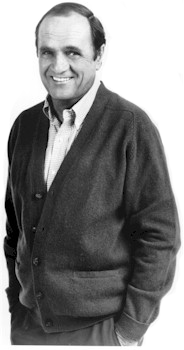 We kept going. Balls and strikes. “Strike zone.” A walk. A single. Moving from base to base. I didn’t know it but I was doing a Bob Newhart routine. Was I making the game seem less bizarre to Robert? All I know is, the more I talked, and the more I explained the game at this elemental level, the more bizarre it seemed to me. Who could invent such a thing?
We kept going. Balls and strikes. “Strike zone.” A walk. A single. Moving from base to base. I didn’t know it but I was doing a Bob Newhart routine. Was I making the game seem less bizarre to Robert? All I know is, the more I talked, and the more I explained the game at this elemental level, the more bizarre it seemed to me. Who could invent such a thing?
As we entered Safeco Field, I apologized to Robert for the weather, which was overcast and drizzly. I apologized for the Mariners, who were not that good. I apologized for the sparse crowd, eventually announced as 20,920, but probably half that. Eight years ago, I said, this place would‘ve been packed.
We bought Ivar’s fish and chips and beer, and grabbed our seats: 300 level behind home plate. I explained road-gray uniforms and home-white uniforms. The players were being announced, which necessitated further explanations: line-up; batting order. “And they can't deviate from this order?” Robert asked. “And after they switch sides and return to offense, do they start at the top again?” Robert asked.
The first Major League pitcher Robert saw in person was Doug Fister, who, the scoreboard proudly displayed, was leading the league in ERA. “What's ERA?” Robert asked. The first Major League batter Robert saw in person was Austin Jackson, the Tigers' rookie center fielder, with a .333 batting average. “What's batting average?” Robert asked. These were easy ones. “Earned runs,” admittedly, was tough. It led to “unearned runs” and “errors” and “official scorers” and this question: “Does it change the outcome of the game or is it just for individual statistics?”
And in the first Major League at-bat Robert ever saw in person, Austin Jackson struck out looking.
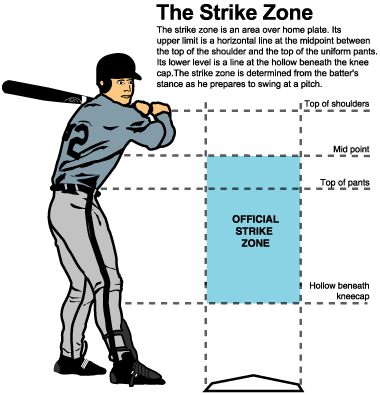 “So what if the ball is outside the strike zone and the batter swings and misses?” Robert asked. That's a strike, too, I said. “What if the ball hits the batter?” That's a hit-by-pitch, I said, and the batter goes to first base. “So how come the batter gets out of the way?” he asked. “Doesn't he want to go to first?” Well, I said, if the umpire thinks he didn't try to get out of the way, then he might not let him go to first base. Besides, it would hurt. The ball is small and hard and thrown between 85 and 100 miles per hour. “Yes,” Robert agreed. “That would hurt.”
“So what if the ball is outside the strike zone and the batter swings and misses?” Robert asked. That's a strike, too, I said. “What if the ball hits the batter?” That's a hit-by-pitch, I said, and the batter goes to first base. “So how come the batter gets out of the way?” he asked. “Doesn't he want to go to first?” Well, I said, if the umpire thinks he didn't try to get out of the way, then he might not let him go to first base. Besides, it would hurt. The ball is small and hard and thrown between 85 and 100 miles per hour. “Yes,” Robert agreed. “That would hurt.”
Things began to click for him when, with two outs and runners on first and second, Brennan Boesch hit a high, high pop fly to left field to end the inning. That's an out, I said.
“Ahhh!” Robert said. “So it doesn't matter how hard he hits the ball, if the fielder catches it before it hits the ground...” Yes, I said, the batter is out. You can hit the ball all the way to the wall, you can hit the ball over the wall, but if a fielder leaps up and catches it before it touches anything, it's an out. Just an out.
Robert nodded. At the same time, throughout the game, he seemed equally impressed by balls that were hit high as those that were hit far. Dull pop-ups to me were majestic things to him.
For the Mariners in the bottom of the first, Ichiro and Figgins went down quickly. When there are two outs, I said, a team is less likely to score any runs. Which is when Franklin Guttierez promptly slapped a single to left and Milton Bradley hit a line-shot homerun over the right-field wall. We stood and cheered. We bumped fists. 2-0!
The M's gave it right back with sloppy play in the top of the second. They couldn't get to ground balls. Double play balls were booted. “It seems the best plan is to hit the ball on the ground,” Robert said. Well, I said, not really. Line drives are the best kinds of hits, but those, too, can be caught for outs. There's a lot of chance in the game. You can perform well and still make an out. You can perform poorly and still get a hit.
A Tiger slapped a single to left and took a wide turn. “He was thinking about going to second,” Robert said, “but he did not want to take the risk.” Exactly, I said.
 In the top of the third, the Tigers threatened again: men on first and second with only one out. But Don Kelly lined the ball to Chone Figgins at second, who doubled off Brandon Inge at first. Doubled off. OK, when the ball is hit in the air, the baserunners can only advance when...
In the top of the third, the Tigers threatened again: men on first and second with only one out. But Don Kelly lined the ball to Chone Figgins at second, who doubled off Brandon Inge at first. Doubled off. OK, when the ball is hit in the air, the baserunners can only advance when...
After that, things went quickly. We had several 1-2-3 innings. Three up, three down. I worried the game would seem long and boring to Robert but he thought it moved fine. He thought American football was long and boring in comparison. “So many timeouts,” he said.
I filled his head with unnecessary minutia:
- The Tigers were one of the original 16 major league teams, dating back more than a century, while the Mariners existed only since 1977.
- Major League Baseball didn't start playing “The Star-Spangled Banner” before games until World War I and it didn't become codified, I believed, until the late 1930s (although it's apparently World War II).
- The 7th inning stretch supposedly began when William Howard Taft, president of the United States from 1909 to 1913, went to a game and stood up after the top of the 7th and everyone followed suit—but I told him this story was probably apocryphal.
- “Take Me Out to the Ballgame,” which we sang during the 7th inning stretch, was over 100 years old.
After 9/11, I added, they also played “God Bless America” during the 7th inning stretch but that's mostly stopped. Then we talked about 9/11. He had the perspective of someone who grew up in the midst of a civil war and didn't expect life to run smoothly. “I thought, you know, this might be bad,” he said about being Lebanese. “It might be like the Japanese with internment camps. But everyone treated me nicely. I didn't have any bad incidents.”
In the end, for all of my apologies at the beginning, we watched a good game. In the 8th it was 3-3, and I was beginning to explain the concept of extra innings to Robert—who, instead of being appalled, rather liked the idea that no game could end in a tie—when, with runners on first and second and one out, Milton Bradley lined a two-strike pitch to right field. Here came Figgins from second! A play at the plate! Safe! I showed Robert the umpire calls for “safe” and “out.” I talked about how it was good that Guttierez was now on third because he had speed and might score on a sacrifice fly, which I also explained, and which was promptly demonstrated when Jose Lopez lofted a shallow fly to center. Guttierez ran. Safe! “He took the risk,” Robert said.
In the 9th, the M's closer, David Aardsma, was announced by the PA announcer with a pirate drawl (“Aarrrrr-dsma”), and to accompanying heavy metal music and heavy metal graphics on the scoreboard. “Quite a production,” Robert said, looking around. Then, referring to Shawn Kelley, who had relieved Fister in the 8th, he added, “The other guy didn't get such a welcome.”
The 9th went quickly. Avila fought off several pitches before popping out to short. Raburn smacked the ball to center but Guttierez drifted under it easily. Then Austin Jackson, who began the game with a strikeout, ended it with a strikeout. The sparse crowd stood and cheered. I looked over at Robert, who smiled.
“So we win,” he said.
We win, I said.
He looked around the field. “You know,” he said, “once you know the basics, this game isn't so difficult.”
Wednesday May 26, 2010
“The Yankee Years” by Joe Torre and Tom Verducci: Special YANKEES SUCK Edition
The New York Daily News called it “One of the best books about baseball ever written,” while The New Yorker named it one of its BEST BOOKS OF THE YEAR, but for the rest of us, “The Yankee Years,” by Joe Torre and Tom Verducci, seems awfully schizophrenic.
It's a mostly plodding hagiography of the 1996-2001 New York Yankees and their even-keeled manager, Joe Torre, but Verducci keeps pushing in directions that undercut the hagiography. He includes a chapter on steroid abuse, for example, that renders irrelevant the team's accomplishments. Clemens blew the Mariners away with one of the best performances in post-season history. (Yay!) But while he was on steroids. (Boo!) Oh, but don't worry, the steroids don't matter. (Huh?) He lists off the ways Michael Lewis' Moneyball changed the game—with teams like the Red Sox valuing previously undervalued stats, like On-Base-Percentage, and prospering as a result. But while Yankees' GM Brian Cashman became a quick if sloppy convert, Torre, the book's hero, never did, continuing to focus on less-measurable aspects of the game like personality and heart.
We 're reminded, again and again, of the four titles Torre helped bring to New York, as if the book were written for the Steinbrenners and Cashman, who unceremoniously cut Torre loose after the 2007 season. We're reminded, again and again, of the grinding qualities those late '90s players, such as Paul O'Neill and Tino Martinez, brought to the team, and how newer players, such as Jason Giambi and Alex Rodriguez, didn't have that same heart, and didn't care enough about the team, which is why, according to Torre, the Yankees stopped winning World Series. But this construct, which is Torre's construct, is later refuted by, of all people, Derek Jeter, who mostly blames lack of pitching for the non-title years. Verducci then backs up Jeter with stats. So which is it? Or which is it mostly? No attempt to clarify this apparent discrepancy is made.
're reminded, again and again, of the four titles Torre helped bring to New York, as if the book were written for the Steinbrenners and Cashman, who unceremoniously cut Torre loose after the 2007 season. We're reminded, again and again, of the grinding qualities those late '90s players, such as Paul O'Neill and Tino Martinez, brought to the team, and how newer players, such as Jason Giambi and Alex Rodriguez, didn't have that same heart, and didn't care enough about the team, which is why, according to Torre, the Yankees stopped winning World Series. But this construct, which is Torre's construct, is later refuted by, of all people, Derek Jeter, who mostly blames lack of pitching for the non-title years. Verducci then backs up Jeter with stats. So which is it? Or which is it mostly? No attempt to clarify this apparent discrepancy is made.
As a result, the book is a fascinating mess. It's also annoying for anyone who hates the Yankees. That's most of us.
Excerpts:
- “The [1996] postseason became a 15-game version of their regular season. The Yankees capitalized on any opening...” (p. 15) ...particularly the opening of Jeffrey Maier's glove.
- “After five games, the 1998 Yankees were 1-4, in last place, already 3 1/2 games out of first, outscored 36-15, at risk of losing their manager and letting teams like the Mariners kick sand in their faces.” (p. 42) Teams like the Mariners? How awful. I'm reminded of that Charles Atlas ad. “That team is the worst nuissance on the beach!”
- “Like Torre, [David] Cone was angered by what he saw the previous night. He watched Seattle designated hitter Edgar Martinez, batting in the 8th inning with a 4-0 lead, take a huge hack on a 3-and-0 pitch from reliever Mike Buddie—five innings after Moyer had dusted [Paul] O'Neill with a pitch.” (p. 44) Wow, Moyer dusted someone? And apparently Edgar violated one of the unwritten rules of baseball: Swinging on a 3-0 pitch when up by four runs in a stadium where David Cone threw 148 pitches and walked in the tying run in the final game of the 1995 ALDS. Edgar should know better than that.
- “'You have to find something to hate about your opponent,' [Cone said in a pre-game speech to his teammates.] 'Look aross the way. These guys are real comfortable against us. Edgar is swinging from his heels on 3-and-0 when they're up by about 10 runs!'” (p. 44) Give or take six runs.
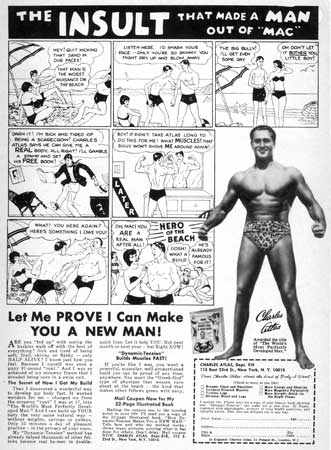 “At some point over the 2000 and 2001 seasons, according to the Mitchell Report, Radomski provided drugs for [Yankees] Grimsley, Knoblauch, pitcher Denny Neagle, outfielders Glenallen Hill and David Justice, and later for pitcher Mike Stanton. In addition, the 2000 Yankees included three other players who later admitted their drug use (though not necessarily specific to that particular year): Jose Canseco, Jim Leyrtiz and Andy Pettitte. Most infamously, the 2000 Yankees had a tenth player who would be tied to reports of performance-enhacing drug use: Clemens.” (p. 105) We're back to the Charles Atlas ad. Mariners kick sand, Yankees beef up. “The INSULT that made steroids users out of 'Yankees'!”
“At some point over the 2000 and 2001 seasons, according to the Mitchell Report, Radomski provided drugs for [Yankees] Grimsley, Knoblauch, pitcher Denny Neagle, outfielders Glenallen Hill and David Justice, and later for pitcher Mike Stanton. In addition, the 2000 Yankees included three other players who later admitted their drug use (though not necessarily specific to that particular year): Jose Canseco, Jim Leyrtiz and Andy Pettitte. Most infamously, the 2000 Yankees had a tenth player who would be tied to reports of performance-enhacing drug use: Clemens.” (p. 105) We're back to the Charles Atlas ad. Mariners kick sand, Yankees beef up. “The INSULT that made steroids users out of 'Yankees'!”- “'Andy [Pettitte] was great,” Torre said. 'I think he taught Roger how to pitch in New York. And Roger taught Andy how to be stronger.'“ (p. 77) ”Stronger.“
- ”Pettitte was a churchgoing, God-fearing Texan, known in the Yankees clubhouse for his integrity and earnestness. If Pettitte was going to cheat, who wouldn't?“ (p. 111) Atheist bastards from Massachusetts?
- ”'It's like Bob Gibson said: “To win a game you'd take anything,”' Torre said. 'We'd all sell our souls. Winning is something that was first and foremost and that's what we wanted to do. Unfortunately, now what stimulates the need to do this is individual performance and not winning.'“ (p. 113) Ah, for the days when players took illegal substances for the good of the team.
- ”There was so much going on, so much in his head, so much emotion coursing through his body, that Clemens could not process the inventory of what was happening at that moment [when Piazza's bat shattered during the 2000 World Series] quickly enough.“ (p. 134) ”...so many steroids coursing through his body...“
- ”The Steroid Era was baseball's Watergate, a colossal breach of trust for which the institution is forever tainted. It floats untethered to the rest of baseball history, like some great piece of space junk, disconnected from the moorings of the game's statistics.“ (p. 117) Including championships in 1996, 1998, 1999 and 2000?
- The [Fenway Park] crowd arrives with the meanness and edginess of a mob.” (p. 80) Yankee crowds, bless them, arrive with smiles and pic-a-nic baskets.
- “Intimidation, and the mere threat that he could go off at any time, was part of Steinbrenner's personal and leadership package.” (p. 122) “Leadership.”
- “No 2000 World Series rings were forthcoming for the scouts, numbering about two dozen. Morale worsened when they were instructed not to bring up the subject of World Series rings at organizational meetings. It worsened still when they saw Steinbrenner cronies such as actor Billy Crystal or singer Ronan Tynan wearing World Series rings.” (p. 143) “Leadership.”
- “[In Steinbrenner's office, there was] a picture of General George S. Patton, given to him by a member of Patton's staff. It was not your typical military portrait. Patton is seen pissing into the Rhine.” (p. 467) Patton: Rhine; Steinbrenner: Baseball.
- “When Jeter was 24 years old and after the Yankees won the 1998 World Series, George Steinbrenner gave a book to him as a present: Patton on Leadership: Strategic Lessons for Corporate Warfare.” (p. 159) No bastard ever got rich by going long on subprime CDOs. He got rich by making the other poor dumb bastard go long on subprime CDOs.
- “Jeter requires fierce, unqualified loyalty from friends and teammates.” (p. 245) Baby.
- “The Yankees [after 9/11] had become not just New York's team, but also America's hometown team.” (p. 148) Fuck you.
- “So it came down to this: Mariano Rivera on the mound with a one-run lead against the bottom of the Arizona lineup [in Game 7 of the 2001 World Series]. Steinbrenner was standing in front of the bathroom mirror, combing his hair, preparing to soon accept the Commissioner's Trophy for a fourth straight year.” (p. 157) Ha!
- “The [2003 World] Series could have gone either way. A sacrifice fly here, a hit there, a little back and core maintenance there, and who knows?” (p. 237) A roided-up pitcher here, a Jeffrey Maier catch there...
- “'They always play Yankeeography in New York on the videoboard. As a visiting player, you see that they get music to hit to and when we come up we get Yogi Berra and Mickey Mantle all the time,' [said Kevin Millar]. Millar walked into the office of [manager Terry] Francona [before Game 6 of the 2004 ALCS]. 'We're not hitting [batting practice] on the field today, Skip,' Millar said. 'We're not falling for any of that Yankeeography crap.'” (p. 304) Ha!
- “The Yankees were saddled not only with the worst collapse in baseball history [in the 2004 ALCS], but also the insult of having the hated Red Sox spill champagne in their stadium.” (p. 311) Ha!
- “Cashman didn't want [Ted] Lilly. He preferred [Kei] Igawa, though Igawa would cost the Yankees more money over four years ($46 million, including the $26 million posting fee)...” (p. 376) Wait for it....
- “'I caught Kei Igawa,' [bullpen catcher Mike] Borzello said... 'He threw three strikes the whole time. His changeup goes about 40 feet. His slider is not a big league pitch. His command was terrible.'” (p. 377) Ha!
- “Just the memory of [the 2003 World Series] pained Pettitte...especially that last night when Beckettt beat Pettitte and the Yankees, 2-0, in what would be the last World Series game every played at Yankee Stadium.” (p. 386) “Our sweetest songs are those that tell of saddest [Yankees] thought” —Percy Shelley (with help from Erik Lundegaard)
- “Damon's teammates grew so frustrated with him [in 2007] that several spoke to Torre out of concern that he was hurting the team. One of them visited Torre one day in the manager's office and was near tears talking about Damon. 'Let's get rid of him,' the player said. 'Guys can't stand him.'” (p. 395) Pssst...Jeter.
- “[Joba] Chamberlain, glistening from the spray and his heavy sweat, was a midge magnet. ... Derek Jeter and Alex Rodriguez, New York's $43 million left side of the infield, were constantly waving their gloves and throwing hands at the little midges. Fighting for their playoff lives, the most expensive team in baseball had developed into a vaudeville act.” (p. 438) This game almost made me believe in God. Or at least plagues.
- “It was 11:38 p.m. when the end came. Jorge Posada swung and missed at a pitch from Cleveland closer Joe Borowski for the final out of a 6-4 Yankees loss. It was the last pitch of the last postseason game ever played at Yankee Stadium.” (p. 462) Jor-ge! Jor-ge! Jor-ge!
- “'Guys, you're playing for the best manager you could possibly play for,' [coach Larry] Bowa told the players. 'He never rips you. He sticks up for you whether you're right or wrong. He gives you the benefit of the doubt on anything...” (p. 405) Until this book, in which Torre basically rips, among others, David Wells, Roger Clemens, Randy Johnson, Jason Giambi, Gary Sheffield, Johnny Damon, Kevin Brown, Chuck Knoblauch, Bobby Abreu and Alex Rodriguez.
- “In another era, the Yankees might have cherry-picked elite pitchers in their prime from organizations that could not longer afford them, in the same way they had plucked David Cone from the Blue Jays in 1995 and Mussina from the Orioles after playing out his contract in 2000. Instead, the Blue Jays locked up Roy Halladay, the Indians locked up CC Sabathia, the Brewers locked up Ben Sheets, the Astros locked up Roy Oswalt and the Twins locked up Johan Santana—all small-market teams who suddenly had the cash to keep their ace pitchers off the trade and free agent markets. The kicker for the Yankees was that under the revenue-sharing system they were financing some of the newfound solvency of those teams.” (p. 421) Has a more self-absorbed paragraph ever been written? The Yankees feel sorry for themselves because they can no longer treat the rest of the Major Leagues like its own farm system? Worse, it's all wrong. The true kicker, not Verducci's kicker, is that all of these pitchers, save one, are not only not “locked up” but now with other teams—including Sabathia with the Yankees. Only Oswalt is still with the Astros...and he wants out.
- “Cashman and the Yankees [in the offseason leading up to the 2009 season] only had just begun to change the story. In 12 days they spent $423.5 million on Sabathia, pitcher A.J. Burnett, who was 31 years old at the time, and first baseman Mark Teixeira, who was 28. ... All told, the Yankees spent $441 million on free agents in that one winter. The rest of the league combined spent $176 million.” (p. 486) The rigged game continues. Rooting for the New York Yankees is like rooting for Goldman Sachs.


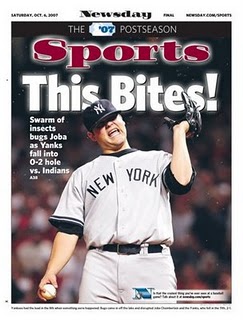
Good times.
Tuesday May 25, 2010
Review: “El Secreto de sus Ojos” (2009)
WARNING: EL SECRETO DE MES SPOILERS
How do you keep the lovers apart? Dramatists have certainly come up with inventive answers over the years: Our families fight, it’s taking forever to return from this war, frankly my dear I don’t give a damn. The Argentinian film, “El Secreto de sus Ojos” (“The Secret in Their Eyes”), comes up with a more mundane and thus universal answer: fear, doubt, passivity. Our eyes may dance but our bodies continue in the dull directions they’re going.
The movie opens with a pivotal scene. A woman at a train station. A bearded man walking away. It feels like the 1970s. He gets on the train and as it’s pulling out she desperately runs alongside and presses her palm to his window. He does the same. She keeps running. He stands up and hurries to the caboose so he can watch her one last time as the train gathers speed and takes him away, away, away from her.
Cut to: a writer, cursing, and scribbling out that scene. Good for him.
He tries again. June 1974. A breakfast on a veranda between a young, handsome couple. They drink tea with lemon—for his sore throat. One gets the feeling it’s the last time he’ll see her.
Bah! Crumpled up.
Then a flash of memory. That same girl, bloodied, raped. The writer bows his head and closes his eyes. Is he the young man on the veranda? The rapist?
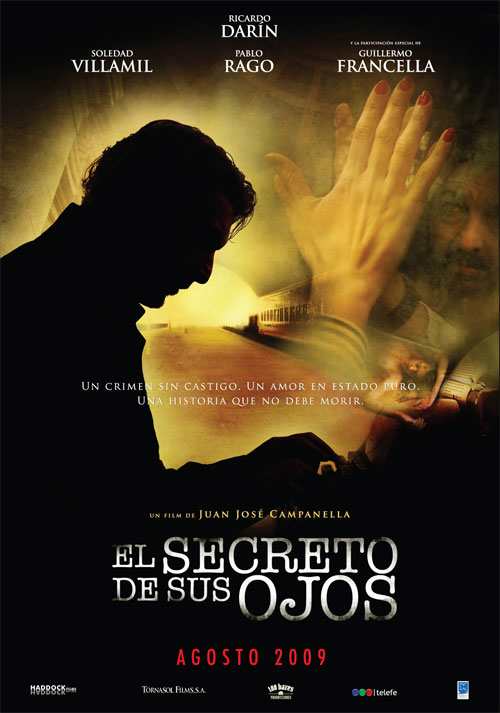 Neither. The writer is Benjamin Esposito (Ricardo Darin), a gray-haired, retired, federal agent in Buenos Aires, who is having trouble writing a novel based upon an old case, the Morales case. We see him walking into his old digs, flirting with attractive women there (“The gates of heaven have opened...” he says), then entering the chambers of an old colleague, his superior, Irene Menendez Hastings (Soledad Villamil). Her pretty eyes dance when he enters but stop dancing (and go sit in the corner) when he brings up the Morales case. That thing again? she seems to be thinking. Nevertheless she brings out an old Olivetti typewriter with a busted “a” key for him to use. We’ll see this typewriter more often, as a running gag, as the movie progresses into the past.
Neither. The writer is Benjamin Esposito (Ricardo Darin), a gray-haired, retired, federal agent in Buenos Aires, who is having trouble writing a novel based upon an old case, the Morales case. We see him walking into his old digs, flirting with attractive women there (“The gates of heaven have opened...” he says), then entering the chambers of an old colleague, his superior, Irene Menendez Hastings (Soledad Villamil). Her pretty eyes dance when he enters but stop dancing (and go sit in the corner) when he brings up the Morales case. That thing again? she seems to be thinking. Nevertheless she brings out an old Olivetti typewriter with a busted “a” key for him to use. We’ll see this typewriter more often, as a running gag, as the movie progresses into the past.
It’s 1974 and Esposito, a federal agent, but more bureaucrat than Bond, argues with colleagues over who gets a new case. No eager beavers here. He and his colleague, Pablo Sandoval (Guillermo Francella), an offhandedly smart man with a drinking problem, draw the short straw, but as soon as Esposito arrives on the crime scene and sees the woman cold and naked on the bed (“Liliana Coloto, 23,” he’s told. “Schoolteacher. Recently married”) he can’t let go of the case. His turnaround is immediate but unexplained. Because the woman is so young and beautiful? Because it’s such a horrible crime?
When informed, the husband, Ricardo Morales (Pablo Rago), seems stunned and talks about how she liked to watch the Three Stooges. Is he a suspect? There are two construction workers working on the building. Are they suspects? It’s not until Esposito sits down with a photo album—which charmingly includes a vellum overlay that identifies all of the people in the pictures—and spots, in shots from her hometown, the same man, Isidoro Gómez (Javier Godino), staring at her, that he has something tangible to go on. It’s the secret in Gomez’s eyes that’s not really a secret. As with most secrets in the movie.
From Gomez’s mother, Esposito and Sandoval learn that Gomez recently moved to Buenos Aires (ah ha!), and is working on a construction site (ah-ha-er!), but he seems to have vanished. They steal letters he sent his mother but they hold no clue, and superiors within Esposito’s office close the case. At the train station, a year later, Esposito runs into, of all people, Morales, who shows up several times a week, after work, waiting for Gomez. This dedication, this passion, reignites Esposito’s, who convinces Hastings, against her superior’s wishes, to reopen the case. But it’s Sandoval who figures out the clue in the letters. (Because there’s always a clue in the letters.) The men Gomez references are not from their hometown; they’re futbol players; and following the movie’s proposition that a man can change many things—his name, his hair—but not his passion, they stake out stadiums. It’s like needle-in-a-haystack, but on the fourth try they find the needle.
Gomez, under questioning, gives up nothing, and Sandoval is off drinking so the good cop/bad cop routine won’t work—until Hastings notices Gomez staring at her blouse and plays bad cop by impugning his manhood (in fairly obvious ways). He falls for it, slugs her, and confesses to the rape/murder to regain his manhood. Case closed. “He’ll get life,” Esposito tells the husband. “Let him grow old in jail,” Morales says. “Live a life full of nothing.”
A year later, Gomez is spotted, not only not in prison, but guarding the president of Argentina, Isabel Peron. Seems in prison he became a snitch for the fascists and was rewarded. Now the fascists are coming for Esposito. They kill Sandoval by mistake and Hastings takes Esposito to the train station so he can get away. It’s there that, embracing, all of their feelings for each other, the secrets in their eyes that aren’t really secrets, spill out; and it’s there that the opening scene—woman running alongside train—is replayed in all of its melodramatic glory.
And that’s pretty much it in terms of backstory. The passion they feel for each other—which, within the story’s construct, can’t change—is put on the back burner. Esposito leaves, lives elsewhere, gets married. Hastings gets married. Question: When they meet at the beginning of the movie, in her chambers, is this the first time they’ve seen each other since the train station? Either way, they continue to tamp down their passion. They pretend otherwise. Like most of us, I suppose.
“El Secreto” is both love story and mystery, and the two are connected in different and not always comfortable ways. The looks Gomez gave Liliana Coloto in photos? Esposito gives Hastings the same looks. Esposito also seems to channel his passion for Hastings into the investigation—which may be why Hastings is always disappointed that he’s still obsessed with the investigation. Me, she seems to be thinking. You should be paying attention to me.
Writing the novel about the case is actually Esposito’s way of continuing the investigation, of finding out what exactly happened to Gomez, and in this regard he visits Morales, now living deep in the countryside. He’s older now, bald, suspicious, but he admits, to this former federal agent, that decades ago he kidnapped Gomez, took him by a railroad track, waited for the noise of a passing train, and put four bullets into him. Case closed! Except as soon as you see his circumstances (living far away from everyone else), and as soon as you recall his earlier lines (“Let him grow old in jail. Live a life full of nothing”), you assume he didn’t kill Gomez; you assume he’s imprisoning him. Which turns out to be the case. Esposito returns at night and finds the old murderer/rapist imprisoned, and a ghost of a man. “Please,” he says to Esposito. “At least tell him to talk to me.” It’s exquisite revenge ruined by how easily we anticipate it—and by the fact that, Morales, in guarding Gomez, is wasting his life, too.
But what now? Esposito had channeled all of his passion into this one case, and the case is closed. He’s also spent the movie keeping his own passion imprisoned. Has he learned? Of course he has. A note he wrote to himself earlier reads “Te mo” (I fear), but now, at the end of the movie, he adds an “a,” making it “Te amo” (I love you); and with that he runs to Hastings’ chambers, where she sees, finally sees, the unguarded look of love in his eyes, and cuts to the chase. “There will be difficulties,” she says. “I don’t care,” he says. They close the door. La final.
“El Secreto,” which won the best foreign language film at the 2009 Academy Awards, is both complex in structure and crowd-pleasing (it’s about love); and, as a writer, how could I not like the early, crumpled-up scenes? At the same time, it feels like the motivations of the characters are too big and clunky to fit into its intricate plot structure. Why, for example, does Esposito get so obsessed with this case? And if Gomez is a man obsessed with one girl, Liliana, as the photos imply, why does he quickly become just a generic creep?
But the bigger problem—besides seeing Gomez’s end far in advance of Esposito—is, sadly, that crumpled-up first scene, the farewell at the train station. The moment Esposito is fleeing the fascists is the moment he realizes Hastings loves him back. But he lets her go. He leaves for 10 years. He never gets in touch with her. Why? Because he’s afraid for himself? Because he’s afraid for her? Because he doesn’t want to implicate her? But she’s already implicated. She was the one who played bad cop to Esposito’s good cop, after all. She humiliated Gomez. If Gomez and his goons are going after him, why wouldn’t they go after her? Because of her social standing? Does that really make her safe? Let’s quote Michael Corleone: “If anything in this life is certain, if history has taught us anything, it’s that you can kill anyone.”
What keeps the lovers apart? Fear, doubt, passivity. At the train station, doubt is removed to double-down on fear, but that doesn’t excuse the passivity. In true love stories, both real and imagined, men must go through hell for their love, to prove their love. Esposito? He can’t even be bothered to get off the train.
Monday May 24, 2010
"Shrek" Sinks Because "Shrek" Stinks
Dreamworks' "Shrek Forever After" opened with the third-highest opening weekend of the year—behind only "Iron Man 2" and "Alice in Wonderland"—with over $70 million domestic (estimated).
A triumph? Not really.
Here are the opening weekends for the four "Shrek" movies. All numbers are adjusted to 2010 dollars:

* Top Critics Only
** All numbers are adjusted to 2010 dollars
That's quite a comedown.
Obviously new films tend to open weaker than sequels, which is what happened with the first "Shrek." But because "Shrek" was good (86% rating on Rotten Tomatoes) it went on to gross $375 million, or no. 3 for the year.
And because "Shrek" was good, its sequel, "Shrek 2," opened gangbusters: $138 million. And because "Shrek 2" was good (88% rating on RT) it went on to gross $564 million, or no. 1 for the year. In fact, until "Dark Knight" and "Avatar" came along, it was the no. 1 movie of the decade.
And because "Shrek 2" was good, its sequel, "Shrek the Third" opened gangbusters: $140 million. But because "Shrek the Third" wasn't good (49% on RT) it went on to gross only $372 million. I know: "only." But that's a $200 million drop from the previous film.
And because "Shrek the Third" wasn't good, its sequel "Shrek Forever After," opened with half the numbers of "Shrek the Third": $71 million. And because "Shrek Forever After" isn't good, either (40%), I assume it'll gross even less. Will it gross $250 million? Will it outdo "How to Train Your Dragon," which is already at $210 million?
Other factors could be at work, of course. The world's complex. Maybe there were simply better options this weekend. Maybe people are finally tired of this 10-year-old franchise. Maybe we don't have the patience for any fourth movie.
But in general I think the above is how moviegoing works—and it tends to be ignored by the powers-that-be. If you keep making a quality version of a beloved product, people will show up. Once the quality slips, the audience slips.
BTW: When referring to "good" and "bad" versions of "Shrek," I'm talking about the general critical reception, which, I argue, and have argued, is on par with general audience reception and word-of-mouth. Me, I only saw the first "Shrek," which I didn't like.
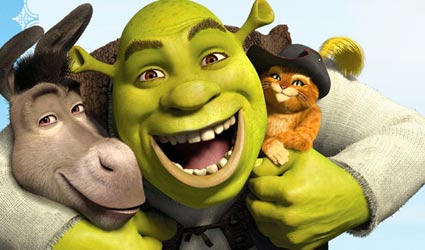
Look, Donkey! Maybe people are finally sick of us!
Sunday May 23, 2010
Target: Fun
Earlier this month I visited friends and family in Minneapolis and took in a game at the new Target Field. It's a great park, surprisingly compact, with narrow foul lines and grandstands right on top of the action. We sat in the left-field bleachers, third-deck, with the Hale Elementary crowd (my nephews' school), which is about as far away as you can get from the action, and we didn't seem that far from the action. It's a vertical stadium, I heard Twins right fielder Michael Cuddyer say the other day, where the winds are trapped and swirl around on the field. It wasn't windy where we were, but man was it cold. It was the day after the first rain-out in Minnesota in 20 years, and temps stayed in the 40s throughout the game. We bundled up, I bought a Twins wool cap at the park, but we were still chilled. Occasionally, to warm up, we'd leave our seats and stand under the heaters outside the Town Ball Tavern. I know: Bud Grant wouldn't approve. But this is baseball.
Here's hoping for a World Series in Minnesota. With snow. To point out the absurdity of Bud Selilg's post-season schedule.

My nephew, Ryan, 6, en route to the game.
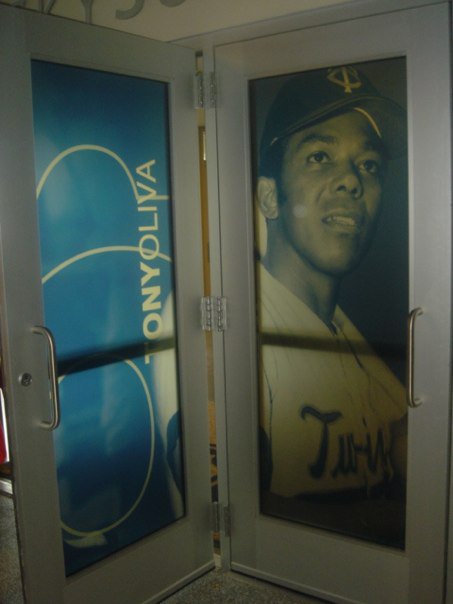
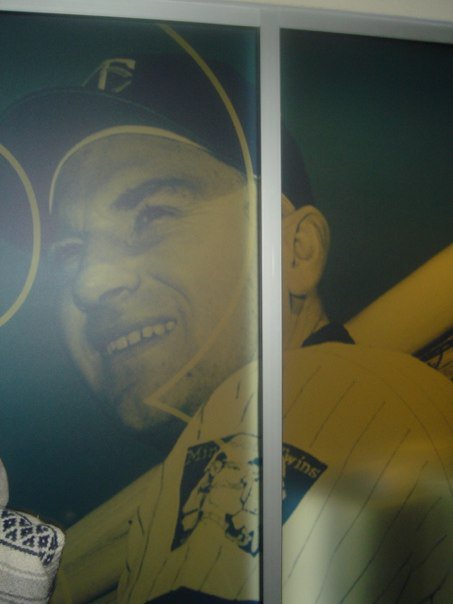
A VIP room on the second deck, where we weren't allowed (not VI enough), but which has the decency to plaster their outer walls with Minnesota heroes: Tony Oliva and Harmon Killebrew.

My father and I walked around the stadium for an hour before gametime—both to see the place and stay warm. Here he is on the second deck on the third-base side, enjoying a rare moment of sunshine. “Minnie” and “Paul,” the original Twins, shaking hands over the Mississippi river, rightly lord over center field.

Outside the Town Ball Tavern, photos of Minnesota “town ball” teams from the turn of the last century are displayed—including this suprisingly integrated team, with three black ballplayers, from the 1910s.
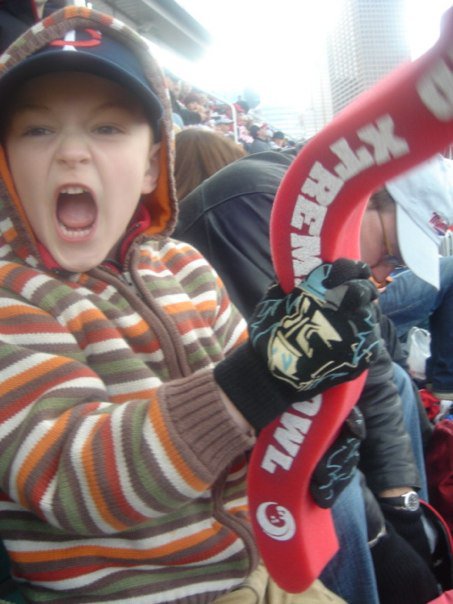
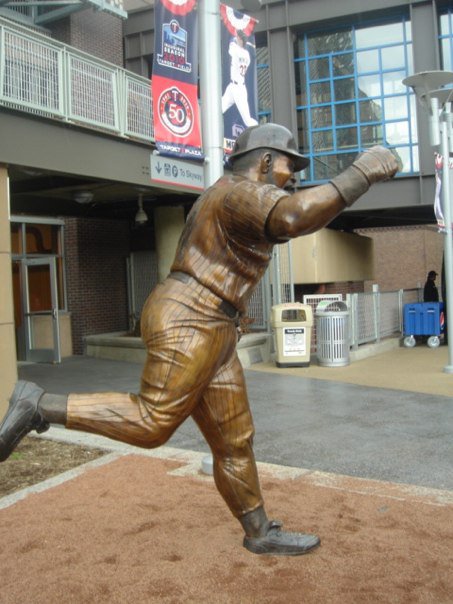
Two Minnesotans exulting: Ryan, in the middle of a 2010 loss to the Orioles, and Kirby Puckett rounding the bases after his walk-off homerun in Game 6 of the 1991 World Series: “Jump on my back, I'll carry you,” he said before the game.

The statue of Harmon Killebrew, who hit 573 homeruns and retired fifth on the all-time homerun list in 1975, behind only Aaron, Ruth, Mays and Frank Robinson. Ryan, emulating, hitting his first.
Saturday May 22, 2010
Waiting for a Superman (Movie)
The other day on Facebook I mentioned that I've only bought eight new songs this year—and it's nearly the end of May. My friend Andy, recently of Hanoi, suggested the latest Iron & Wine collection, which I promptly bought, and which includes this cover of the Flaming Lips' song “Waiting for a Superman.” It's quite beautiful. You can listen to it here, but, as always, I recommend buying. Support your local artists. Even when they're not local.
Here are the lyrics:
I asked you a question
I didn't need you to reply
Is it getting heavy?
But then I realized
It's getting heavy
Well I thought it was already as heavy as can be
Is it overwhelming
To use a crane to crush a fly?
It's a good time for Superman
To lift the sun into the sky
Because it's getting heavy
Hell I thought it was already as heavy as can be
Tell everybody
Waiting for Superman
That they should try to
Hold on the best they can
He hasn't dropped them, forgot them or anything
It's just too heavy for Superman to lift
The people working on the next Superman movie should listen to this song over and over. The question they need to answer, to make the movie work, is right here: What's too heavy for Superman to lift?
Answer that and you've got a story.
Oh, and I'm still taking suggestions for new music if anyone's got ideas.
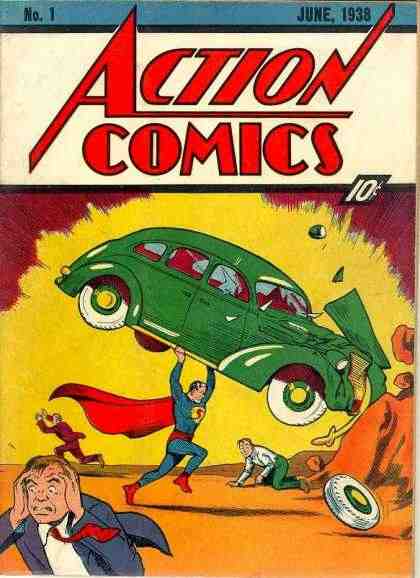
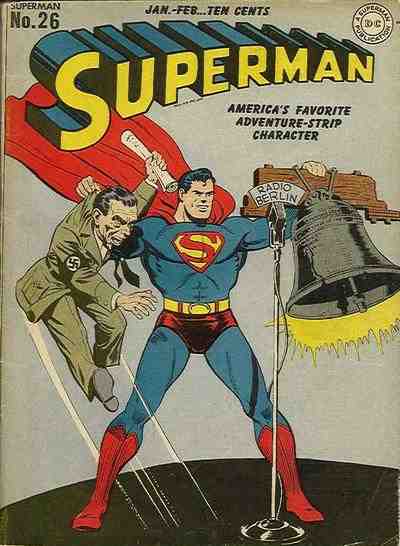
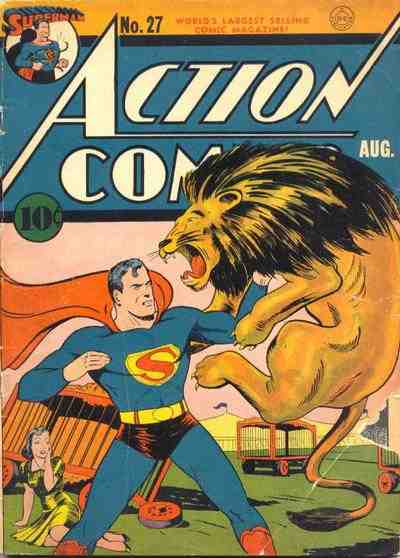
Things Superman can lift: a car, a lion, Goebbels.
Friday May 21, 2010
Dowd on Dowdy
This is one of the dumber paragraphs I've read this week, and, big surprise, it comes from Maureen Dowd. Lamenting media coverage of Elena Kagan, Dowd dissects the difference between "single" and "unmarried" and writes of the double standard women endure:
But if you have a bit of a weight problem, a bad haircut, a schlumpy wardrobe, the assumption is that you’re undesirable, unwanted — and unmarried.
Not only is this not a double standard—since it applies to men, too—but it seems the very definition of undesirable in our culture: fat and dowdy.
Dowd's real complaint is that a male version of Kagan—successful, outgoing, but no George Clooney—would still be seen as a sexual being, but this is because of a different double standard: the premium women place on male success. The problem, if you even want to view it as a problem, is yours, Maureen.
The whole column is an embarrassment. I don't doubt news coverage of Kagan has been awful, but Dowd's corrective is no corrective.
Thursday May 20, 2010
All-Star Game: Vote Early and Often
How odd that they encourage us to vote more than once for the All-Star Game. Is Bud playing the numbers game? Twenty-three million ballots cast! A new record! People care! Sure, but 10 million were cast by Joe Schlumpfo, unemployed, in Des Moines.
Here's the ballot cast by Erik Schlumpfo, writer/editor, in Seattle:
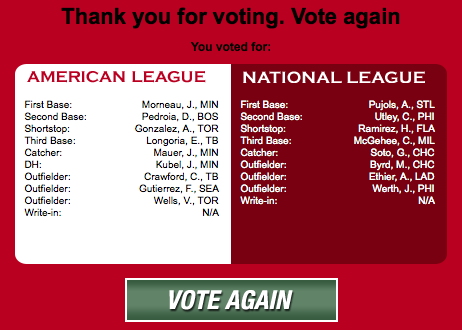
I'm Twins-heavy, I know, and Yankees-deficient, but that's the fun of it. Kubel gets in just for the grannie off Mo.
Go here to vote—under the "related coverage" box. Vote early and often. Let's keep the starting nine Yankee-free.
Wednesday May 19, 2010
Review: “Iron Man 2” (2010)
WARNING: HEAVY METAL SPOILERS
I thought it wouldn’t work. I thought too many villains and partners (Whiplash and Black Widow and War Machine and Nick Fury?) would sink the thing, like they sank “Batman Forever,” and “Batman and Robin,” and “Spider-Man 3.” Instead the movie plays like a good three-issue arc of a 1970s comic book. Plus we’re teased with more Avengers stuff—a little Captain America here, a little Thor there—but, FYI, you have to stay through the credits for a peek at some aspect of the Son of Odin. (Psst: it’s not Chris Hemsworth.)
 The movie opens with Tony Stark (Robert Downey, Jr.) on top of the world but with a “Top of the World, Ma!” quality to him. He’s rich, powerful, and as Iron Man he’s brought about world peace, but he’s more self-destructive than ever. Maybe because he’s self-destructing. His blood is slowly being poisoned by the whatchacalm in his chest that turns him into Iron Man. He tests himself. Blood toxicity: 19%. Then 24%. Then 53%. Oops.
The movie opens with Tony Stark (Robert Downey, Jr.) on top of the world but with a “Top of the World, Ma!” quality to him. He’s rich, powerful, and as Iron Man he’s brought about world peace, but he’s more self-destructive than ever. Maybe because he’s self-destructing. His blood is slowly being poisoned by the whatchacalm in his chest that turns him into Iron Man. He tests himself. Blood toxicity: 19%. Then 24%. Then 53%. Oops.
Meanwhile, three other things threaten to take him down:
- In Russia, Ivan Vanko (Mickey Rourke), the son of his father’s former business partner, who blames the Starks for his father’s boozy death, uses age-old blueprints to come up with his own whatchacalm in his chest and turns himself into the supervillain Whiplash;
- In Washington D.C., a U.S. Senator, aptly named Stern, but played comically by Gary Shandling, demands that Tony Stark turn over the Iron Man outfit to the U.S. Army in the interests of national security; and
- Stern’s military-industrial-complex partner, Justin Hammer of Hammer Industries (Sam Rockwell), jealous to the max, tries whatever he can to outdo his rival.
All of these threats coming down on him at once actually play to the strengths of the lead actor. Downey, Jr. has always felt like a pursued man to me, as if he were racing, physically and psychologically (mostly psychologically), to stay ahead of everything that wants to overcome him. So it makes sense to make Stark a pursued man, too, who keeps distracting himself with the next big thing. He begins a year-long Stark Expo in Flushing Meadows, NY, he testifies before the Senate Armed Services Committee and refuses to share his toys, he gives control of his company to his assistant, Pepper Potts (Gwyneth Paltrow), and he races cars at the Grand Prix in Monte Carlo. This last is where Whiplash appears and takes out two cars, including Stark’s, and then strolls menacingly forward. You can only run so fast, Tony. Things always catch up. Even when they stroll.
Can I pause here to thank Darren Aronofsky? Without Aronofsky’s “The Wrestler,” Rourke’s career wouldn’t have been resurrected enough for studio execs to allow him to play an A-list role in an A-list movie, and he’s a perfect counterpoint to the star. Stark/Downey, Jr. is a babbler, whose mouth, working overtime, still can’t keep up with his mind. Rourke/Vanko is the opposite. Everything he does is slow. He walks slowly, talks slowly, shifts his toothpick from one side of his mouth to the other slowly. He serves his revenge cold. If Stark’s pace is the result of frenetic intelligence—one thought pushing out another—Vanko’s leisurely pace almost feels like wisdom. When Stark visits Vanko in his Monte Carlo jail cell, he talks shop, “Pretty decent tech,” etc., but Vanko has the bigger picture in mind. “You come from a family of thieves and butchers,” he says, with that deliciously thick Russian accent. “And like all guilty men, you try to rewrite your history, to forget all the lives the Stark family has destroyed.” He is exactly what you want in a villain. Not someone to boo and hiss, but somebody almost more admirable than the hero. Someone to make you consider switching sides.

He's smart, cool, slow, and likes birds. Who wouldn't root for him?
As Stark’s enemies get closer, his self-destruction gets worse. He whoops it up at his birthday party—his last, he believes—and skeet-shoots with his Iron Man blasters to the delight of half-naked girls. He battles his friend, Lt. Col. James “Rhodey” Rhodes (Don Cheadle, taking over, for some reason, from Terrance Howard), who steals one of his Iron Man suits and delivers it to the U.S. military, who delivers it to Justin Hammer. Nice friend. Nice military-industrial complex. It’s the second time Rhodes has played sap for Hammer against Stark. To be honest, it’s not much of a role.
There’s other silly stuff. Apparently Pepper and Natalie don’t get along...until they do. When Tony is ready to tell Pepper he’s dying is the exact moment she’s unwilling to listen to him. There are father issues—because there are always father issues these days—and the old man (John Slattery of “Mad Men”), via a scratchy film from the 1960s, gives his son a 40-year-old puzzle that provides...wait for it...the key to curing the toxicity in his blood! That’s some foresight from Daddyo. Not to mention a vague ripoff of “Da Vinci Code” and “National Treasure.” Note to Hollywood: The world isn’t a puzzle. Everything doesn’t fit together. Your usual lies are lies enough.
I thought the casting of Scarlet Johansson as Black Widow was silly, too, but thanks to personal trainers and special effects it works. And lord knows she works that suit. There’s a scene where she enters a diner from behind that’s just... Mercy. At the same time, is there too much blankness in her eyes? Something passive and uncalculating? Samuel L. Jackson doesn’t seem to be having as much fun with Nick Fury as he should, while Cheadle, ever dour, looks positively trapped when his visor rises in his Iron Man suit. Gwyneth? Another thankless role. She’s an assistant turned CEO, and love interest to a man who doesn’t seem interested in love. At the end of “Spider-Man 2” we want, almost desperately, for Peter Parker and Mary Jane to get together, but there’s so little chemistry between Stark and Potts that when they kissed I thought, “Oh, right. He’s supposed to love her.”
Rockwell as Hammer is a delight: all bullying CEO bluster. He's the hollow man, as hollow as an Iron Man suit. The screenplay by Justin Theroux isn’t bad, either. There’s a nice play on the words Google and ogle, Stark dismisses Fury’s “Avengers” overtures thus, “I don’t want to join your super-secret boy band,” and when Hammer introduces a sexy Vanity Fair reporter to Tony, we get this exchange:
Justin Hammer: Christine's doing a spread on me.
Pepper Potts: She did a spread on Tony last year.
Tony Stark: Wrote an article too.
Director Favreau, also playing the hapless Happy Hogan, Tony Stark’s chauffer, gives us a sense, more than in most superhero movies, what it’s like to be a civilian in the midst of a superhero battle. Gods battle above you. Buildings fall around you. It's scary stuff. It works. The movie, mostly thanks to Downey, Jr. and Rourke, works.
But where to go from here? How about away from the East-West dynamic (too Cold War) and toward a greater Mideast-West dynamic? Or instead of the cartoonish jealousy of a Justin Hammer, why not have genuine worry from the military-industrial complex about the money and influence they’re losing in the age of Iron Man? Along with their misconceived attempts to get it back?
Of course I’d happy if the next movie simply went in the direction of one call...

'Nuff said!
Tuesday May 18, 2010
Armond White's Review of “Robin Hood” —with Footnotes
Every Man for Himself
Russell Crowe plays Ridley Scott’s everyman again—this time with arrows
By Armond White
At a reported cost of over $200 million, according to the London Telegraph, Ridley Scott’s Robin Hood refutes the old altruistic axiom “rob from the rich and give to the poor.” All the charm and meaning has been taken out of this reboot. It’s now a “history,” opening with a detailed inscription to establish the 12th-century tale’s seriousness: “In times of tyranny and injustice, where law oppresses the people, the rebel takes his place in history.” In other words, Gladiator II.
I assumed the title card was an homage to earlier cinematic version of “Robin Hood” rather than a call to seriousness. Who knows? But every major “Robin Hood” movie has begun with such a description.
Russell Crowe once again plays Scott’s everyman hero who rises above his taciturn machismo to avenge dreadful memories—clever shtick for the wealthy duo that like to pretend they’re doing something besides just raking it in.
Question: how is this not a potential criticism of any movie in which a star plays an everyman? Movie stars are wealthy; everymen are not. Was it shtick for Crowe to play an everyman hero in “L.A. Confidential”? And what’s the point of guessing at the motivations of Crowe and Scott? What does that have to with what’s on the screen?
Their nouveau-riche narcissism imagines having a populist purpose, yet the clichés of Robin Longstride’s archery skills, put to use in the English army’s campaign against the French while, back home, Marian Locksley (ludicrous Cate Blanchett) tills her impoverished, overtaxed fields, don’t speak for the people, except in distant, almost invisible metaphor.
I had to read this sentence several times to fathom its meaning... and I still don’t quite fathom its meaning: “...the clichés of Robin Longstride’s archery skills....don’t speak for the people...”? WTF? In general, White seems to be saying that the film pretends to be populist but isn’t. Maybe: It’s the one Robin Hood movie in which King John and Robin Hood fight side-by-side. On the other hand: It’s the only Robin Hood movie where Robin is a commoner, where none of the royals, including Richard, are particularly worthy, and where the end game is not the return of King Richard (and a more benevolent monarchy) but the adoption of the Magna Carta (and the beginning of liberty for all). Some might consider this a populist message.
And the motto these oppressed Brits live by (“Arise and arise until lambs become lions”) isn’t about Tea Party insurrection; it merely replaces poetic generosity with vengeance.
Does White want the motto to reflect Tea Party insurrection? Admittedly “Rise and Rise Again” is an odd slogan for this movie, since Crowe as Robin is always a lion, and so doesn’t need to rise and rise again to become one. But it works if one thinks of the Magna Carta as the end game. We all must rise again until we stop being sheep and become men.
Scott and Crowe return to Gladiator’s violent formula because the high-life confessions of their “A Good Year” collaboration didn’t click. But they also seem to be chasing after Antoine Fuqua (the director Scott replaced on American Gangster) in the way Robin Hood repeats the insipid realism of Fuqua’s 2004 King Arthur, the grungy, anti-poetic reboot of Arthurian tales. Both films represent a dullard’s version of history; Hollywood’s commercial calculation has become so obvious that it removes beauty from storytelling. Screenwriter Brian Helgeland’s period setting over-simplifies the context for violence—reusing his Braveheart formula but without director-star Mel Gibson’s conviction.
Why would they be chasing after Fuqua—“King Arthur” failed miserably. And what exactly is the commercial calculation in removing beauty from storytelling? Let’s face it, there’s not much in the plot here that is commercial. It is, in fact, the least commercial of all the Robin Hood movies since it never even gives us Robin Hood.
Look at Scott’s superficial “beauty”: a couple of dusk landscapes (amazingly subtle lighting by John Mathieson) and a splendid view of French ships roiling on blue, misty waves. But these are not “cinematic” images; they’re mini TV commercials that lack existential vision. Ultra-hack Scott reverts to the slickness of his advertising background. TV imagery has pervaded cinema to the point that Scott doesn’t balance his over-cropped TV-style close-ups with the postcard vistas. Like Gladiator’s jarring F/X, it shows Scott’s disrespect for cinema.
White piles insults upon opinions here. It’s all air. There’s nothing to even push against.
Fake beauty and fake history rob Robin Hood of previous moral value. It’s no longer “legendary” because Scott and Helgeland’s sham realism trivializes history. They pretend how history happened (Monty Python-style) but their embarrassing, anachronistic rip-off of Saving Private Ryan’s beachfront battle scene shows no feeling for how history is constructed and passed down through ritual, repetition and affection. An abstract end-credits sequence is more imaginative (it’s in the style of Scott’s Scott Free company logo). In place of inspiration, Robin Hood has the bloat of a 1960s roadshow presentation: Costly, overlong but with no intermission—or reprieve.
The previous moral value of Robin Hood stories has been greatly exaggerated. In older stories, Robin is basically a noble fighting a disreputable royal until a better, war-mongering royal returns, so life can continue as is. This Robin is using his luck to actually push for reform. I’m not saying Scott’s “Robin Hood” is a good movie. I’m saying White, in his ad hominem attacks, doesn’t delineate any of the reasons why it’s not good.

Back in '38, when, according to White, “Robin Hood” had a true populist message: to fight and bow before a benevolent, warmongering monarch like King Richard the Lionheart (Ian Hunter, above).
Monday May 17, 2010
Lancelot Links
- Fascinating post by Sex in a Submarine's William Martel on the long, sad road "Robin Hood" took to the big screen. Once upon a time, he says, there was a much ballyhooed screenplay called "Nottingham," in which the RH tale is told from the Sheriff's perspective. Russell Crowe signed to star as the Sheriff. They just needed a director...
- Check out Felix Salmon's thoughtful New York Times Op-Ed on the future of the futures market for Hollywood movies. He thinks the studios, who are against it, and lobbying Congress to make it illegal, have the most to gain from it. Me, it might be the one futures market I'd have a chance in hell in.
- And the battle to reign in copyright infringement in the digital age continues. The FCC has allowed studios to encode video-on-demand with a signal that prevents set-top boxes from recording that content, while music publishers are suing profitable Web sites from posting song lyrics without license. Quote from David Israelite, the chief executive of the National Music Publishers’ Association, which represents more than 2,500 publishers: "The digital age has provided a chance to re-evaluate the value of the words." He adds, "[It] hasn’t been exploited very well." Understatement of the year, bro.
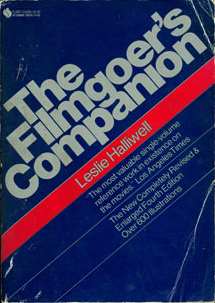 Via IMDb.com, Jessica Barnes of Cinematical lists her favorite books about movies, and readers chime in. Off the top of my head, I'd go with: David Thomson's "The Whole Equation," Edward Jay Epstein's "The Big Picture," Mark Harris' "Pictures at a Revolution," Peter Biskind's "Easy Riders, Raging Bulls," and David Mamet's "Bambi vs. Godzilla." If we're talking influential, then my no. 1 is "The Filmgoer's Companion," Fourth Edition, 1974, by Leslie Halliwell. Dog ears should be so dog-eared.
Via IMDb.com, Jessica Barnes of Cinematical lists her favorite books about movies, and readers chime in. Off the top of my head, I'd go with: David Thomson's "The Whole Equation," Edward Jay Epstein's "The Big Picture," Mark Harris' "Pictures at a Revolution," Peter Biskind's "Easy Riders, Raging Bulls," and David Mamet's "Bambi vs. Godzilla." If we're talking influential, then my no. 1 is "The Filmgoer's Companion," Fourth Edition, 1974, by Leslie Halliwell. Dog ears should be so dog-eared.- Via a Sean Axmaker FB status update, here's Richard Thompson singing, believe it or not, "Oops... I did it again." He nails it, too.
- Is "This Much I Know" a regular Guardian column? Good idea—even if the title reminds me of Homer Simpson botching the title of that right-wing record album, "This [sic] Things I Believe." Guardian's latest version is from Malcolm Gladwell. Of the things he knows this much, some are interesting ("We need more generalists"), some are obvious ("I prefer great songwriters to politicians"), and one, near the end, just feels wrong: "Hollywood is strangely indifferent to questions of faith, while the rest of America is consumed by them." Counter-argument: Most of America isn't consumed by the questions of faith so much as by the desire to see their faith validated. Hollywood used to do this, with their Biblical epics in the '20s, '50s, '60s, but it's a bigger world now, a bigger market, and while sometimes the Christians come out to spite those they feel are spiting them ("The Passion of the Christ"), mostly they just stay at home ("The Nativity Story").
- Good article on The Atlantic site on what's wrong with "Glee."
- Also from The Atlantic: Odd, creepy encounter between Donald Rumsfeld and Alex Gibney, documentarian ("Taxi to the Dark Side"), at the White House Correspondents' Dinner. Rumsfeld: "Abu Ghraib... That was a terrible thing." OK, so maybe that was the understatment of the year. Not a big fan, by the way, of the WHCD. It always has a "Nero fiddles" feel. With one exception.
- Hawaii's had enough of the Birthers. And who hasn't?
- The best lines I've read on the Junior-sleeping-in-the-clubhouse controversy is in this post from a New York Yankees fan. Read it and laugh. Or weep. Or just shake your head sadly.
- Finally, here's a special "Iron Man 2" quote for the New York Yankees and their invincible closer Mariano Rivera: "If you can make God bleed, people will cease to believe in Him. There will be blood in the water. And the sharks will come." Touch 'em all, Jason Kubel!

Sunday May 16, 2010
Robin Hood — Libertarian?
Here's my favorite part of A.O. Scott's review of the new “Robin Hood”:
Meanwhile — and believe me, there is a whole lot of meanwhile in this crowded, lumbering film —...
Here's my least-favorite part:
You may have heard that Robin Hood stole from the rich and gave to the poor, but that was just liberal media propaganda. This Robin is no socialist bandit practicing freelance wealth redistribution, but rather a manly libertarian rebel striking out against high taxes and a big government scheme to trample the ancient liberties of property owners and provincial nobles. Don’t tread on him!
Yes, Robin Hood, in legend, is most famous for robbing from the rich and giving to the poor, but Hollywood, liberal Hollywood, has never followed suit. In the Fairbanks version in 1922, Robin and his men sing about it (“We rob the rich, relieve distressed...”), and an arrow quivers close to “the Rich Man of Wakefield,” but that's about it. Otherwise they're against Prince John's excessive taxes. The Flynn version during the Depression? That caravan they rob is full of Prince John's tax money. Costner? He does rob a wealthy man, and takes the necklace off of his comely daughter, but he, too, is mostly about getting back tax money. Ditto Patrick Bergin the same year. You can take issue with it, but don't pretend it's anything new. Hollywood always makes it personal, not political.
Plus the libertarian line is just silly. The libertarian assumption is that we're all free and government enslaves us. The 12th century assumption is that we're all enslaved, at the whim of a king who is chosen by God, so Robin tries to use government, i.e., kingly decree, to free us. We're talking different planets.
Most important, and please accept the usual SPOILERS here, the fault of the new “Robin Hood” movie isn't that Robin Hood does't rob from the rich and give to the poor; it's that he never becomes Robin Hood.
Ah, well. At least Scott's review isn't as bad as Armond White's.
Saturday May 15, 2010
Review: “Robin Hood” (2010)
WARNING: IN TIMES OF TYRANNY AND INJUSTICE, WHEN LAW OPPRESSES THE PEOPLE, THERE WILL BE SPOILERS
Last month, in touting “The Adventures of Robin Hood” with Errol Flynn, I wrote:
It takes the Fairbanks version an hour, and the Costner version 45 minutes, to get us where “Adventures” gets us in five minutes: Robin Hood in Sherwood messing with the bad guys.
I kept thinking of this line while watching Ridley Scott’s new, updated “Robin Hood.” Because how long does it take Scott to get us to the point in the story where we want to be? Five minutes? Forty-five? An hour?
How about the entire frickin’ movie?
You know those scenes from the trailers? King John: “I declare him to be an outLAAAAAAAW!” Sheriff of Nottingham: “Nail, please.” [Cue arrow splicing between his fingers.] Those aren’t from the middle of the movie. They’re from the last three minutes. This is an origin issue. It’s a prequel. It’s “Robin Hood Begins.” You have the oldest Robin Hood ever (Russell Crowe, 46) playing the youngest Robin Hood ever.
Here’s the question: Is this a bad thing?
 The movie begins in France, where King Richard (Danny Huston), returning from the Crusades, stops to sack a castle and get some dough to make up for all the money he lost in the Crusades. Among his men, some common archers: Robin Longstride (Crowe), Will Scarlett (Scott Grimes, Malarkey in “Band of Brothers”) and Allan a’Dayle (Alan Doyle).
The movie begins in France, where King Richard (Danny Huston), returning from the Crusades, stops to sack a castle and get some dough to make up for all the money he lost in the Crusades. Among his men, some common archers: Robin Longstride (Crowe), Will Scarlett (Scott Grimes, Malarkey in “Band of Brothers”) and Allan a’Dayle (Alan Doyle).
At the end of a day’s battle, this Robin apparently likes nothing better than making a little money with the old shell game, but Little John (Scott Grimes) thinks he’s cheating. He’s not. They get into a brawl anyway. At that same moment, King Richard, with his right-hand man Sir Robert Loxley (Douglas Hodge), is walking disguised among his troops, searching like Diogenes for an honest man. He finds one. “What is your opinion of my Crusade?” he asks Robin. “Will God be pleased with my gesture?” Pause. Pause. “No, He won’t,” Robin says in Crowe’s quiet, firm voice. Robin talks about the massacre at Acre, about the killing of women and children that Sean Connery’s Robin Hood referenced in “Robin and Marian.” He talks about the look a Muslim woman gave him before he beheaded her. It wasn’t anger; it was pity. “She knew when you gave the order,” he adds, “we would be Godless. All of us.”
Honest answer. Cut to: Robin and his men in the stockades.
The next day Richard is killed by a common French archer, and Robin gathers his men so they can attempt to cross the channel before the three thousand now-kingless soldiers try to get back on their own. On the way, they encounter the king’s horse, riderless and carrying the crown in a satchel, and discover the king’s men, including Loxley, ambushed. Ambushing the ambushers, Robin’s arrow cuts the cheek of the fleeing and treasonous Godfrey (Mark Strong), who has secretly allied himself with King Phillip of France against his old friend Prince John. Then Robin hears the dying words of Loxley. The nobleman asks the commoner to deliver his sword—with the words, “Rise and Rise Again. Until Lambs Become Lions” on the hilt—to his father. Robin nods. Loxley dies. Then Robin adopts Loxley’s identity. Few will question knights and noblemen carrying the king’s crown. Commoners would be lucky not to be hanged.
All of this, thus far, is pretty smart. The longer the legend of Robin Hood has endured, the more names he has been given. So why not have the confusion begin during his lifetime? Later versions of the tale, too, turned him from a commoner/thief to an aristocrat wrongfully dispossessed of his lands, and Hollywood, in its umpteen versions, has played along. So why not, in our more democratic time, explain it all away? Robin is a commoner. He’s merely disguised as a nobleman. The first of his many disguises.
What’s not smart is the way the 72-year-old Scott handles the early deaths. Richard is allowed final words and rising choir music. How much more effective if he’d just died. From king—ffftt!—to corpse in a second. Loxley needs to say his final words, to further the plot, but both he and Richard don’t need the rising choir music. They’re godless now, remember? Move along, Ridley. Move along.
That said, the scene where the crown is returned to London is surprisingly touching. The royals wait at the end of a long dock for Richard to emerge from his ship; instead there’s this Loxley man with the crown. No words are spoken. Everyone knows. Then Richard’s mother, Eleanor of Aquitaine (Eileen Atkins), accepts the crown with gravity, and with greater gravity, knowing the disaster that awaits, puts it on the head of her ne’er-do-well son, John (Oscar Isaac), while his French pastry of a girlfriend, Isabella of Angoulême (Léa Seydoux), trembles with excitement at becoming queen. The scene turns amusing as John, overcome, is about to reward Loxley, until he realizes, essentially, “Wait a minute. Loxley? Your father owes me back taxes,” and pockets the reward.
Robin, still pretending to be Loxley, plans on returning the sword to the father, Sir Walter Loxley (Max von Sydow), and tells his doubtful men, “We can’t repay good luck with bad grace.” Great line. Also good move. His good grace winds up being repaid with even better luck. At the Loxley estate, Sir Walter asks him to continue a ruse the old man didn’t know he’d begun. He asks him to play his son. He likes the cut of Robin’s jib, he has no heir, and when he dies, Marion, Loxley’s wife (Cate Blanchett), will lose it all. It’s win-win for everyone. Robin accepts, and, for a time, the movie becomes a kind of “Return of Robin Guerre.”
Unfortunately the plot thickens and thickens. King John sends Godfrey to collect taxes from the northern Barons to pay for Richard’s wars, but Godfrey’s plan is to burn and pillage so that, when Phillip invades, the country will be divided. Meanwhile, Robin learns his father, a stonemason, was put to death when Robin was six for, in essence, creating one of the greatest documents in western civilization, the Magna Carta, giving rights to noblemen and binding the king to law. Thus when Godrey’s perfidy is discovered and Phillips’ intentions known, Robin, still playing Loxley, and still riding the king’s white horse, breaks the impasse between barons and King John by resurrecting his father’s old idea. The barons will fight for king and England, but John will grant them rights and bind himself to law. And off they go, almost two hours into the two hour, 20 minute movie, to the southern coast of England to fight the French. With nary a sign of Sherwood Forest in sight.
Going against expectations isn’t a bad thing—and in Hollywood, with its love of formula, it’s normally applauded—but “Robin Hood,” from title to trailer, feels like false advertising. Even “Batman Begins,” with “begins” in its title, gives us Batman halfway through. This thing is called Robin Hood, for god’s sake, and the opening title card tells us, “In times of tyranny and injustice, when law oppresses the people, the outlaw takes his place in history.” But Robin isn’t made an outLAAAAAAAW until three minutes before credits. Is it setting up another movie? And has that one been filmed yet? Because Crowe, bless him, isn’t getting any younger or thinner. It’s as if we were promised sex, but the girl frittered away the evening and left us with the mere hope, that maybe, in two years time, we might finally have that sex. We can’t help but leave her place confused and dissatisfied.
Listen: I love Crowe in these roles. Costner’s Robin Hood failed, in part, because he wasn’t much of a leader. Crowe is. One can’t imagine not following him into battle, and not because he gives this or that speech, but because there’s a stillness to him, a toughness, an honesty. The quieter his voice gets, the tougher he reveals himself to be. I go back to that early scene in “L.A. Confidential” when he confronts the wife beater. Standing on his lawn, hands in his pockets, relaxed and not, a conversational voice: “Why don't you dance with a man for a change?” He has that quality here. He can reveal his authority in acquiescence. “Ask me nice,” he says to Marion, as she, in their ruse, divvies up sleeping arrangements. Robin gets to sleep with the dogs. Others might be mad, but he’s half-amused, accepts it as a given, and charmingly seems at home on those dirty blankets. He rubs the belly of the mutt closest to him like it’s an old friend. I was reminded of Brando with the cat. Apparently great actors can act with animals without being upstaged.
But because Crowe works doesn't mean the movie isn't dry and overlong. Remember the thrill watching the guy become the guy in other recent origin tales, such as “Batman Begins” and “Casino Royale”? We don’t get that here. Maybe because it’s telling a different tale than the one we know.
For that, at least, give Scott and screenwriter Brian Helgeland credit. They are fixing what’s wrong with the Robin Hood legend from our more modern perspective. Generally the story’s about a nobleman surreptitiously fighting a corrupt usurper until the real ruler, a wayward, warmongering king, returns. You have to bend the language pretty hard to make anyone care about that these days. So they’ve given us a commoner who will force the king, the legitimate but corrupt king, into recognizing the legal rights of his subjects. Much better, thank you.
But a “Robin Hood” movie still needs a Robin Hood.
Friday May 14, 2010
From the Old Man
 “As long as you're grading all the Robin Hood movies by category, don't forget the score. The Errol Flynn version had, to my mind, the best movie score ever written. It was written by Erich Korngold, the greatest musical prodigy since Mozart, who emigrated to Hollywood from Hitler's Germany and didn't do much except write a hauntingly lovely violin concerto.”
“As long as you're grading all the Robin Hood movies by category, don't forget the score. The Errol Flynn version had, to my mind, the best movie score ever written. It was written by Erich Korngold, the greatest musical prodigy since Mozart, who emigrated to Hollywood from Hitler's Germany and didn't do much except write a hauntingly lovely violin concerto.”
—Bob Lundegaard, in an e-mail to his ne'er-do-well son, Wednesday.
Thursday May 13, 2010
Everything You Need to Know About Robin Hood... *
* ...but didn't ask. Review of the new movie will be up Saturday. Hopefully.
What’s Robin’s official name/title?
- 1922: The Earl of Huntingdon
- 1938: Sir Robin of Locksley
- 1976: Robin
- 1991 (GB): Sir Robert Hode, Earl of Huntingdon
- 1991 (US): Sir Robin of Locksley
- 2006 (BBC): Robin, Earl of Huntingdon, in the first episode. Sir Robin of Loxley when he marries Marian in the second season.
- 2010: Robin Longstride
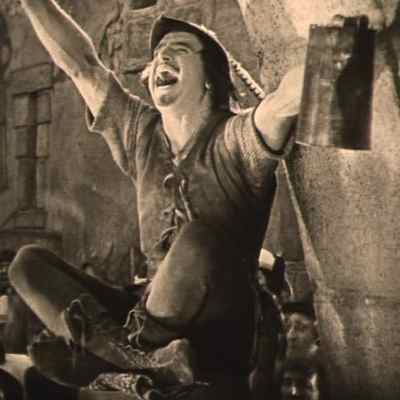

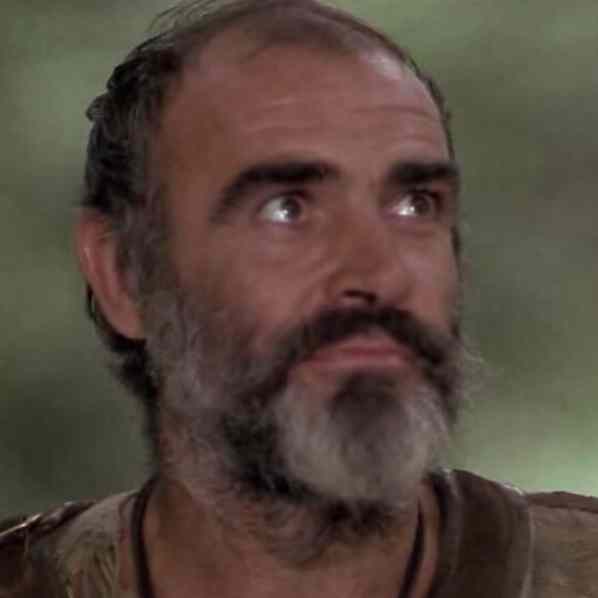




Many faces. Fewer hats and feathers.
Who is his right-hand man?
- 1922: John Little
- 1938: Will Scarlett
- 1976: John Little
- 1991 (GB): Will Scarlett
- 1991 (US): Azeem, the Moor
- 2006 (BBC): Much, the Miller’s Son
- 2010: He doesn't really have one
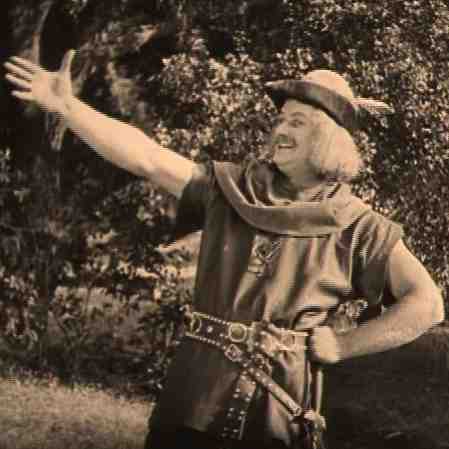
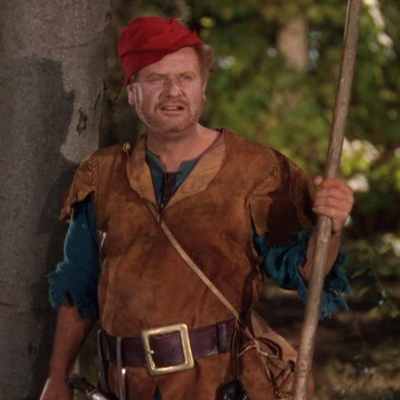
Alan Hale played Little John three times: in ‘22 and ’38 (above),
and in “The Rogues of Sherwood Forest” (1950), his final role.
Who’s Missing? (Or why Alan-a-Dale is the Rodney Dangerfield of the Merry Men)
- 1922: Much, the Miller’s Son
- 1938: Alan-a-Dale
- 1976: Alan-a-Dale; Guy of Gisbourne; and Much, the Miller’s Son
- 1991 (GB): Alan-a-Dale; and King Richard
- 1991 (US): Alan-a-Dale; and Prince John
- 2006 (BBC): No one. Yep, not even Alan-a-Dale.
- 2010: Guy of Gisbourne; and Much, the Miller’s Son. Which means we have our first cinematic Alan-a-Dale in 88 years! Welcome back.



The forgotten merry man, in 1922, 2006 and 2010.
Who's the main villain—Sir Guy of Gisbourne or the Sheriff of Nottingham?
- 1922: Sir Guy of Gisbourne, who tries to kill King Richard in the Holy Land and has his eye on Lady Marian Fitzwalter. The Sheriff of Nottingham is a walk-on.
- 1938: Sir Guy of Gisbourne, who duels memorably with Robin Hood in the end. The Sheriff of Nottingham, in comparison, is fat, cowardly, and used for comic relief.
- 1976: The Sheriff of Nottingham. There is no Sir Guy of Gisbourne in this version.
- 1991 (GB): Sir Miles Folcanet (basically Sir Guy of Gisbourne). Baron Daguerre (basically the Sheriff of Nottingham) helps unite Norman and Saxon in the end.
- 1991 (US): The Sheriff of Nottingham, who has his eye on the throne. His cousin, Guy of Gisbourne, battles Robin early and often but is killed by the Sheriff for a) failing to kill Robin, and b) getting robbed in Sherwood Forest.
- 2006 (BBC): The Sheriff of Nottingham. In the first season Sir Guy takes Robin’s lands, then tries to take Robin’s woman (and eventually kills her), but by the third season he actually joins the Merry Men. The Sheriff is always the bad guy and always the man with the real power.
- 2010: Godfrey. The Sheriff’s a joke. Sir Guy doesn’t exist. Yet.

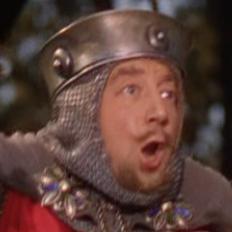


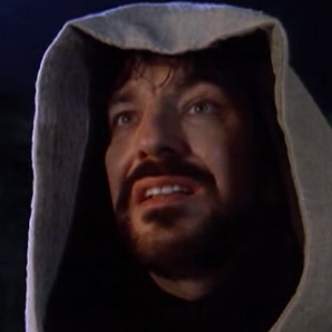
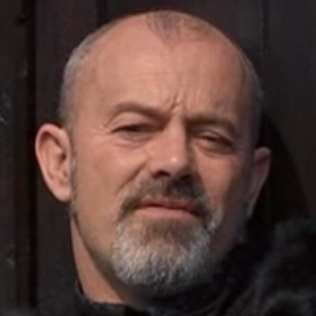
Six faces of the Sheriff of Nottingham: From walk-on in ‘22
to a man eyeing the throne of England in ’91.
How does Robin demonstrate his archery prowess?
- 1922: A piece of wood is tossed into the air and he shoots two arrows into it. Everyone else, at best, can only shoot one arrow into the wood.
- 1938: In the final round of an archery contest, Philip of Arras shoots a bullseye but Robin splits his arrow. As a child I thought: “Doesn’t that mean they tied?”
- 1976: In the end, posioned, he shoots an arrow out the window from his deathbed. Where it lands is where he’ll be buried.
- 1991 (GB): In a contest to prove his worth to a band of outlaws, their best archer, Harry, comes within inches of a piece of wood at 100 paces. Robin splits the wood.
- 1991 (US): He shoots a weapon out of Will Scarlett’s hand and splits a rope that is hanging one of his men. Also, in a nice touch, he run the feathers through his mouth before doing any shooting.
- 2006 (BBC): What doesn’t he do? He just doesn't kill anyone.
- 2010: He grazes the face of the fleeing Godfrey in France and later kills the fleeing Godfrey on British beaches with a distant, arced shot.

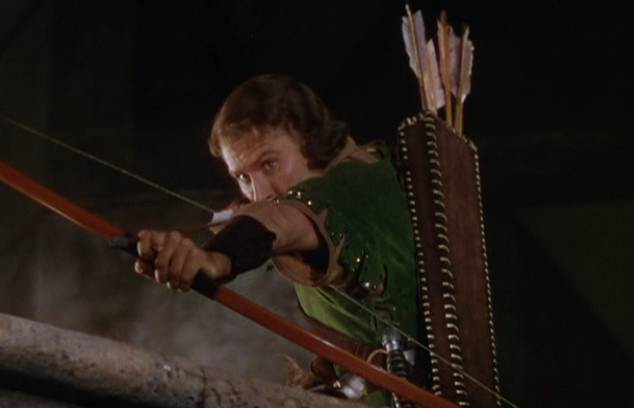

In what way does Robin rob from the rich and give to the poor?
- 1922: A poor boy gets coins. An arrow comes within a whisker of killing “The Rich Man of Wakefield.“ The Merry Men also sing a song (silently) about their feats:”We rob the rich, relieve distressed/ On damned John to score/ We’ll take a life if sorely pressed/ Till Richard reign once more.“ But that’s about it.
- 1938: Robin makes his men swear an oath “to despoil the rich, only to give to the poor,” but we don’t see much despoiling. They memorably rob the caravan, led by Sir Guy and the Sheriff, but that’s guv‘ment money.
- 1976: I’m not sure he does. When he returns to Sherwood 20 years later, he learns people are singing songs about him. “Everywhere we go, they want to hear the things that you did,” Will tells him. To which Robin replies, “We didn’t do them.”
- 1991 (GB): When the Baron raises taxes, Robin and his men steal the taxes. When the Baron raises the reward money on Robin’s head, Robin decides to give the tax money back to the people as a way to keep them on his side. “It’s their money anyway,” he says. Again, though, he’s mostly stealing taxes. The rich, wherever they are, are relatively safe.
- 1991 (US): Ditto. Although one rich man loses his purse and his comely daughter loses her necklace. Insert vice-versa joke here.
- 2006 (BBC): Yes, probably, but it’s mostly a battle between Robin and the Sheriff, with the usual TV fluff.
- 2010: He doesn‘t.
Why do Robin and his men storm the castle at the end?
- 1922: To rescue Marian.
- 1938: To prevent Prince John from declaring himself King of England. Also to rescue Marian.
- 1976: He doesn’t; the final battle takes place in a field next to Sherwood Forest.
- 1991 (GB): To rescue Marian from a forced marriage.
- 1991 (US): To save his men from a hanging and to rescue Marian from marriage/rape.
- 2006 (BBC): They actually storm out of the castle, leave the Sheriff in it, and blow the damned thing up. Nice touch.
- 2010: The castle, French, is stormed at the beginning.
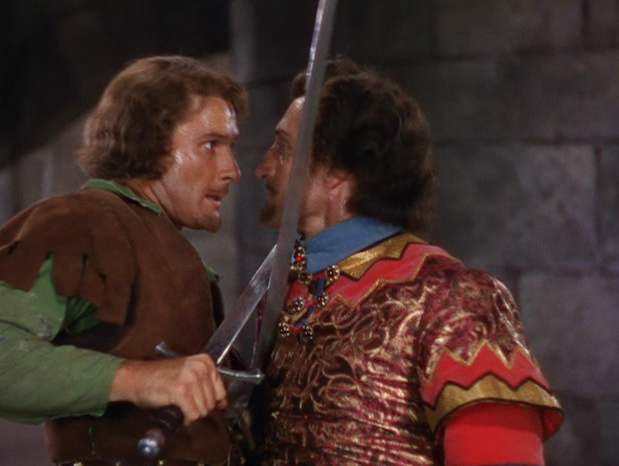
Guy: “Do you know any prayers, my friend?”
Robin: “I’ll say one for you!”
Who dies?
- 1922: Guy of Gisbourne (by Robin Hood)
- 1938: Guy of Gisbourne (by Robin Hood)
- 1976: Robin Hood (by Marian); the Sheriff of Nottingham (by Robin Hood); and King Richard (to madness and disease)
- 1991 (GB): Sir Miles Folcanet (by Robin Hood)
- 1991 (US): The Sheriff of Nottingham (by Robin Hood); and his mother (by Azeem the Moor)
- 2006 (BBC): Robin Hood (by Isabella, Guy’s sister); Maid Marian (by Guy of Gisbourne); Guy of Gisbourne (by the Sheriff of Nottingham); Alan-a-Dale (by the Sheriff of Nottingham); and the Sheriff of Nottingham (by Robin Hood). The thing’s got more deaths than Hamlet.
- 2010: King Richard (to a French arrow).

Final shot.
Wednesday May 12, 2010
Review: “Robin Hood: Prince of Thieves” (1991)
WARNING: WHEN SPOILERS WERE ROTTEN
“Robin Hood: Prince of Thieves” is as uneven as Kevin Costner’s accent within it. It begins gritty and ends in high camp. Robin is heroic, then childish, then heroic again. He assumes leadership of a band of outlaws without being a leader, and he’s actually upstaged in almost every department (dignity, warmth, love) by his right-hand man, Azeem (Morgan Freeman), who demonstrates more leadership in professing to follow Robin Hood than Robin Hood does in professing to lead anyone. Robin can’t even win a swordfight against a high-camp version of the Sheriff of Nottingham (Alan Rickman) without the old knife-from-the-boot trick. Aside from some pretty cool archery skills, one wonders why this guy became the legend. Shouldn’t we be watching the story of Azeem, Thief of Hearts?
 “Prince of Thieves” is the third major film version of Robin Hood and it’s interesting to see how it deviates from the Fairbanks and Flynn versions. Most notably, the Crusades were still celebrated in ’22; and though the ’38 version mixed in a strong sense of post-WWI isolationism (get your own house in order, Jack, before traipsing off to foreign lands), the movie is seen from a wholly Christian perspective, beginning with the opening title card:
“Prince of Thieves” is the third major film version of Robin Hood and it’s interesting to see how it deviates from the Fairbanks and Flynn versions. Most notably, the Crusades were still celebrated in ’22; and though the ’38 version mixed in a strong sense of post-WWI isolationism (get your own house in order, Jack, before traipsing off to foreign lands), the movie is seen from a wholly Christian perspective, beginning with the opening title card:
In the year of our Lord 1191 when Richard, the Lion-Heart, set forth to drive the infidels form the Holy Land, he gave the Regency of his Kingdom to his trusted friend, Longchamps...
The language in the ’91 opening title card is less dramatic:
800 years ago, Richard “The Lionheart,” King of England, led the third Great Crusade to reclaim the Holy Land from the Turks. Most of the young English noblemen who flocked to his banner never returned home.
Royalty disappears. In ’22, King Richard and Robin are best friends. In ’38, Richard and Robin fight side-by-side in the third act. By ’91, Richard, now with quotes around “The Lionheart,” is relegated to a last-minute wedding blessing, while Prince John, the main villain in the first versions, is nowhere to be seen. He’s been replaced by the Sheriff of Nottingham, who, in ’22, was a walk-on, and in ’38 was comic relief. Here he actually has his eye on the throne. He also has a name, George, which adds nothing, and a devil-worshipping witch-mother, which adds nothing but weirdness.
Right-hand man? From Little John (’22) to Will Scarlett (’38) to Azeem, the Moor.
Will Scarlett? Turns out he’s Robin’s illegitimate half-brother.
Marian? She’s nearly raped on camera, to comic effect.
The thing’s a mess.
It begins in a Turkish prison in Jerusalem, 1194 A.D., where Holy Crusaders are being tortured and maimed. Robin, with five years hair and beard growth, stoically volunteers himself for a maiming instead of his friend Peter. “This is English courage,” he says with an American accent. Then he breaks himself free, along with Peter, and a nearby Moor, Azeem, who promises to show the way out. In the escape, he loses Peter, brother of Marian, to an arrow, but gains Azeem. “You have saved my life, Christian,” Azeem says. “I must stay with you until I have saved yours. That is my vow.” He says all this with Morgan Freeman’s voice, which makes it even cooler.
We later learn that Robin was a bit of a brat as a child—the Sheriff calls him a “whelp” and Marian tells him: “All I remember of you is a spoiled bully who used to burn my hair”—but his years in prison seem to have changed him. Until he returns to England. Then he seems a child again. He guffaws when he finds out why Azeem was locked up. “Because of a woman? That’s it, isn’t it? That’s it!” A scene later, he sobs into Azeem’s chest when they find the skeleton of Robin’s father strung up in a cage at the remains of Locksley Manor. I suppose the filmmakers wanted character development but, for the viewer, it’s such a sharp contrast to our stoic English prisoner. The unevenness has begun.
Robin quickly makes enemies with Guy of Gisbourne (Michael Wincott), cousin to the Sheriff, and he, Azeem and the blind servant, Duncan (Walter Sparrow), flee into Sherwood Forest. There, across a large stream, he tangles with a band of outlaws, notably John Little (Nick Brimble), and bests him by taking him by surprise. Back at the outlaws’ camp, he suggests fighting back against the powers-that-be. Everyone scoffs but he makes trouble in town, cutting the Sheriff’s cheek, and raising the bounty on his head—a source of pride with him. There’s a nice dynamic here that should’ve been underlined: The more Guy and the Sheriff search for Robin, the more homeless people they create, and the more these people wander into Sherwood and become part of Robin’s army. Will Scarlett (Christian Slater), with a huge chip on his shoulder, blames Robin for their misery, and Azeem counsels against forging an army (“Christian, these are simple people, they are not warriors”), but it all comes together anyway. Arrows are made, people are trained, treehouses are created. Friar Tuck, a bit of a drunkard, is brought aboard and initially clashes with the infidel, until, for the 10th time in the movie, Azeem uses his superior scientific knowledge—this time to help a breach baby get born. Then they’re pals.
The Sheriff, meanwhile, flailing inside his castle, fights back with black arts, treachery, and fierce Celts from the North. After Marian is abducted, Duncan, the blind servant, unknowingly leads the Sheriff and the Celts back to Robin’s hideout. Though Robin’s army handle the first assault, they cannot withstand a barrage of flaming arrows and either flee, die or are captured. The Sheriff then threatens the lives of children to force Marian to wed him—to link him to royal blood so he’ll have an avenue to the throne—and, to honor their wedding day, he plans to hang 10 of the merry men in the town square. Robin, of course, and the few survivors (Azeem, Little John, his wife, Will Scarlett), plan otherwise. But no one’s plan works as planned.
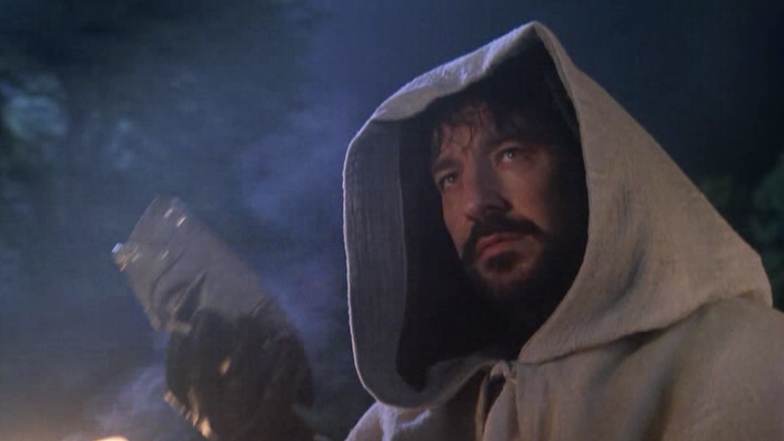
Before the Sheriff goes off to camp.
The Flynn version was not only clean of grit and bad language, it was clean in terms of storytelling: 102 minutes and out. The Costner version, in comparison, rambles and shambles, hesitates and backtracks for either 143 minutes, or an interminable 155 minutes in the extended version, and a lot of this is unnecessary. Did we really need Celts, for example? Did we need the black-arts subplot? I’ll give you Will as Robin’s half-brother, even if it leads to one of the worst line readings in the movie (Robin: I have a brother? I have a brother!); but did we also need to find out the witch was really the Sheriff’s mother? Alan Rickman got raves next to Costner when the movie came out, but he’s so over-the-top he’s really in another movie. He’s in a comedy. Alright I’ll say it: he’s awful. The only thing more awful are some of his lines. When in angry mood: “No more table scraps for the orphans... And call off Christmas!” When visiting his torture chamber: “Sorry to keep you hanging about.” As for the end—when he tries to rape Marian at the altar in front of the Bishop? To what end? Look, he’s a smart-enough guy. His world is crashing all around him, and marrying and impregnating Marian would stop none of the crashing. It’s only there to provide this temporary tension for the audience: Can Robin stop the rape in time? Wow, he does.
Costner, whose acting I defended a few years back, has his moments, particularly when he needs to be heroic, dashing, athletic. He can do these things but seems reluctant to do them. At times he also has gravitas. Then he opens his mouth, trying for that British accent, and out comes mostly flat, nasal Californian. Planning for the final assault, he suddenly adopts what sounds like a Bronx accent. As a joke? Were there no other takes? Who edited this thing? His 1991 mullet doesn’t hold up, either. Can Robin Hood ever have a decent haircut?

He's good in the action scenes...and when not opening his mouth.
Tuck’s British accent—the actor is from Massachusetts—is pretty lousy, too. Mastrantonio is fine, beautiful, and Freeman as always is a joy. That look of pure delight on his face when the little girl at camp asks him if God painted his face. His speech before the townspeople after the hangings go awry: “ I am not one of you but I fight for you! I fight with Robin Hood!” It’s a great moment but it underlines Robin’s own lack of leadership. Shouldn’t Robin have given such a speech? At least once?
Michael Wincott makes an effective, scary Gisbourne. He’s the villain the movie should’ve had. But overall the thing is a mess. Director Kevin Reynolds gives us a long sloppy affair that’s full of movie clichés. Marian, scared, hears noises in her home. Oh, whew, it’s just a cat. No it isn’t! Battles rage, but, oh whew, the Sheriff and his witch-mother are dead. No, she’s isn’t!
So what did all of this mean? The second-highest domestic gross of 1991: $165 million. But gross doesn’t necessarily mean popularity. I’d argue “Robin Hood: Prince of Thieves” was one of those movies, like “Spider-Man 3” or “Indiana Jones and the Kingdom of the Crystal Skull,” that everyone went to see, and then everyone agreed that everyone shouldn’t have gone to see it. It wasn’t necessarily robbing from the rich, but it was definitely robbing.
Tuesday May 11, 2010
Robin Hoods: How Holy are the Crusades?
1922 (Fairbanks):
Very! “In far-off Palestine,” a title card reads halfway through the film, “Richard meets with victory and concludes a truce with the infidel.” Afterwards we see Arabs marched through the streets while an English knight on horseback takes a lazy bite out of an apple. There’s never a sense that the Crusades are not a good idea.
1938 (Flynn):
Mixed. The opening titles trumpet the Crusades: “In the year of our Lord 1191 when Richard, the Lion-Heart, set forth to drive the infidels from the Holy Land...” But, reflecting American attitudes in 1938, we also get a strong isolationist bent, as Robin blames King Richard and the Crusades for the recent unpleasantness with Prince John, Sir Guy and the Sheriff: “His task was here at home defending his own people instead of diverting it to fight in foreign lands,” Robin says. Appropriately, this Robin is also the only one who doesn't go off to fight in the Crusades.
1976 (Connery):
Decidedly unholy. The crusades, reflecting post-Vietnam sensibilities, are a sad, dispirited affair, while King Richard, instead of being a great hero, is a near madman who kills women and children for, as Robin tells him, “a piece of gold that never was.” Robin relays the pointlessness of the Crusades to Marian back in Sherwood. She asks if he’s sick of the fighting and he responds: “On the 12th of July, 1191, the mighty fortress of Acre fell to Richard. His one great victory in the whole campaign. He was sick in bed and never struck a blow. On the 20th of August, John and I were standing on a plain outside the city, watching, while every Muslim left alive was marched out in chains. King Richard spared the richest for ransoming, took the strong for slaves, and he took the children, all the children, and had them chopped apart. When that was done he had the mothers killed. When they were all dead, 3,000 bodies on the plain, he had them all opened up, so their guts could be explored for gold and precious stones. Our churchmen on the scene—and there were many—took it for a triumph. One bishop put on his mitre and led us all in prayer. (Pause) And you ask me if I’m sick of it.”
1991 (Costner):
Unholy. Robin’s decision to join the Crusades severs him from his father, who is killed by the Sheriff of Nottingham in his absence. When Robin returns to his father’s grave, he says, “I should’ve been here. [Father] called the Crusades a foolish quest. Said it was vanity to force other men into our religion.” Later, in rallying his not-so-merry men, he declares, “One free man defending his home is more powerful than 10 hired soldiers. The Crusades taught me that.” Plus the wisest man in the entire movie is Robin's right-hand man, Azeem the Muslim (Morgan Freeman), whose telescope frightens Robin (“How did your uneducated kind ever take Jerusalem?” Azeem says), and who gives a better rallying speech than Robin ever does: “I am not one of you but I fight for you! I fight with Robin Hood!” In a perfect world he’d be the star. OK, he was the star.

2006 (BBC):
“Bloodthirsty.” That's how Robin reponds in the first episode when asked how the Holy Land is. Later he questions the whole enterprise: “Is it our holy war? Or is it Pope Gregory’s?” Turns out he’s developed a broad, 21st-century view of this narrow, 12th-century conflict. “You know why I went to war?” he says. “To recover Jerusalem, to recover our Holy Land. [But] when I got there I met the Muslims, I met the Jews. And I realized it was their Holy Land, too.” A Muslim girl, pretending to be a boy, Djac, joins the merry men for 22 out of 39 episodes. Like Azeem, she has a magnifying glass. Like Azeem, she’s rarely wrong. Like Azeem, she’s proud. In her first episode she refuses to renounce her God to save her skin: “Why would I pretend to be Christian?” she says. “You killed my people in the name of Christianity.” No one takes a lazy bite out of an apple.
2010 (Crowe):
Unholy. Early in the film, King Richard, sacking a French castle upon his return from the Crusades, walks disguised among his troops, searching, like Diogenes, for an honest man. He finds one in Robin Longstride and asks him: “What is your opinion of my Crusade? Will God be pleased with my gesture?” Robin pauses, then pauses, then says, “No, He won’t." Like Connery's Robin, this Robin talks about the massacre at Acre, about the killing of women and children. He talks about the look a Muslim woman gave him before he beheaded her. It wasn’t anger; it was pity. “She knew when you gave the order,” he says, “we would be Godless. All of us.”
Monday May 10, 2010
Robin Hoods: How Tough Is Maid Marian?
1922: Enid Bennett as Lady Marian Fitzwalter:
Not. She fakes suicide to escape the lecherous advances of Prince John, then hides in a neaby convent while waiting the return of Robin, Earl of Huntingdon. Later she’s kidnapped, and Robin storms the castle to save her. When all hope seems lost, he hands her a knife so she can kill herself rather than be dishonored by the lecherous advances of Guy of Gisbourne. She’s basically a pale, frail thing who veers between death and dishonour.
1938: Olivia de Havilland as Maid Marian:
Not much. Sure, she rides in the middle of the night to a Saxon pub and comes up with the plan that saves Robin from hanging. Otherwise she’s a very sweet Norman girl who starts out a bit prejudiced against the Saxons, then falls in love with a Saxon lord. Oh, and by the end she needs rescuing from a dungeon. Go figure.
1976: Audrey Hepburn as Lady Marian
This one’s tricky. In the beginning she gets punched in the face by Robin, then breaks down when telling him how much it hurt to lose him, so she seems a pushover. At the end she kills Robin with poison rather than lose him again, so she’s clearly not. Plus, for the first and only time, she gets equal billing. The movie’s called “Robin and Marian."
1991: Elizabeth Mastrantonio as Marian Dubois:
When we first see her she’s a masked figure who kicks Robin in the groin (always good for a laugh). By the end she’s nearly raped by the Sheriff of Nottingham (which the movie, with its tin ear, plays for laughs). She starts out tough then winds up weak and in need of rescuing—the opposite of Audrey’s arc.
1991: Uma Thurman as Maid Marian:
Not only does she staunchly refuse the hand of Sir Miles Folcanet (basically: Sir Guy of Gisbourne), but she pretends to be a boy to infiltrate Robin’s band. (Since this is Uma, that’s one helluva wrap job.) In the end, she is forced to go along with the wedding but is saved by Robin, whose forces she joins in battling Sir Miles. She swings down on a rope and takes out three knights like they‘re bowling pins.
2006: Lucy Griffiths as Marian:
She’s not just Marian, the girl fought over by Robin of Locksley and Sir Guy of Gisbourne; she’s also The Night Watchman, the masked avenger whose exploits around Nottingham predate Robin’s. So not only does she not need rescuing, thank you very much, she’s actually the world’s first masked superhero.
2010: Cate Blanchett as Marion Loxley:
Legally, she doesn’t have many rights. Her husband dies and his father, Sir Walter Loxley, tells the messenger, Robin Longstride, to pretend to be her husband so they can keep their land. (If Walter dies, she loses it all.) But this doesn't mean she's not a tough cookie. She works the fields with her peasants, fends off the advances of the Sheriff of Nottingham, kills a French soldier trying to rape her, and, in the end, joins the barons, like a British Joan of Arc, in battling back a French invasion on southern British shores. Take that, Enid Bennett!

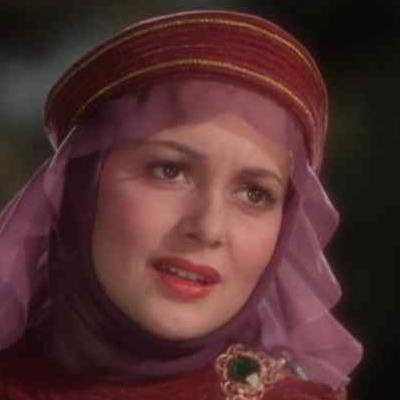
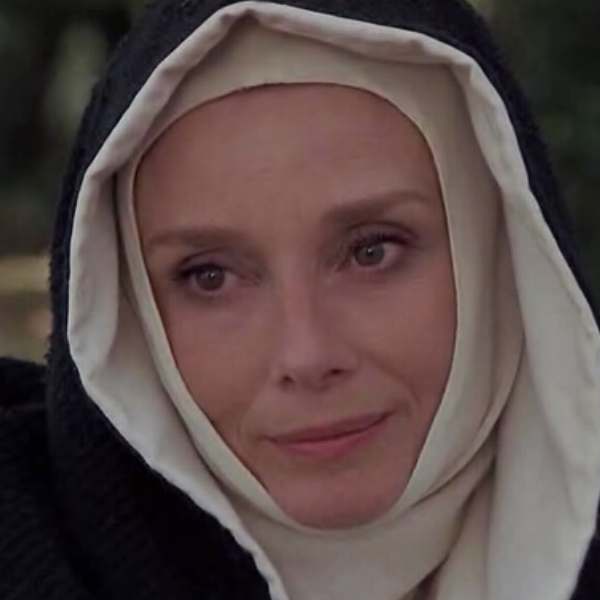



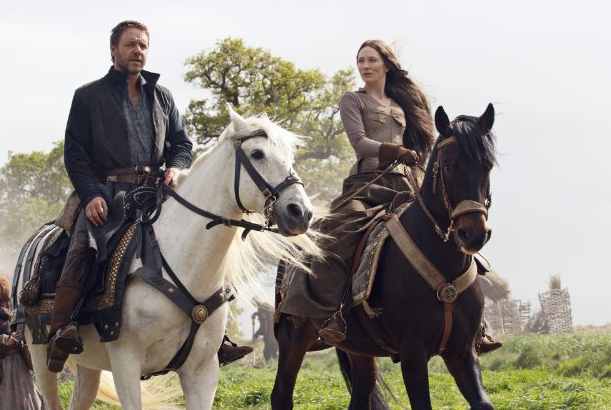
Manly, yes, but I like it, too.
Sunday May 09, 2010
Robin Hoods: How Grandiose are the Opening Title Cards?
1922 (The Douglas Fairbanks version)
“Medieval England—England in the Age of Faith. Her chronicles tells of warriors and statesmen, of royal Crusaders, of jousting knights. Her ballads sing of jolly friars, of troubadours, of gallant outlaws who roamed her mighty forests. History—in its ideal state—is a compound of legend and chronicle and from out both we offer you an impression of the Middle Ages – ”

1938 (The Errol Flynn version)
“In the year of our Lord 1191 when Richard, the Lion-Heart, set forth to drive the infidels from the Holy Land, he gave the Regency of his Kingdom to his trusted friend, Longchamps, instead of to his treacherous brother, Prince John. Bitterly resentful, John hoped for some disaster to befall Richard so that he, with the help of the Norman baron, might seize the throne for himself. And then on a luckless day for the Saxons...”

1991 (The Kevin Costner version)
“800 years ago, Richard “The Lionheart,” King of England, led the third Great Crusade to reclaim the Holy Land from the Turks. Most of the young English noblemen who flocked to his banner never returned home.”
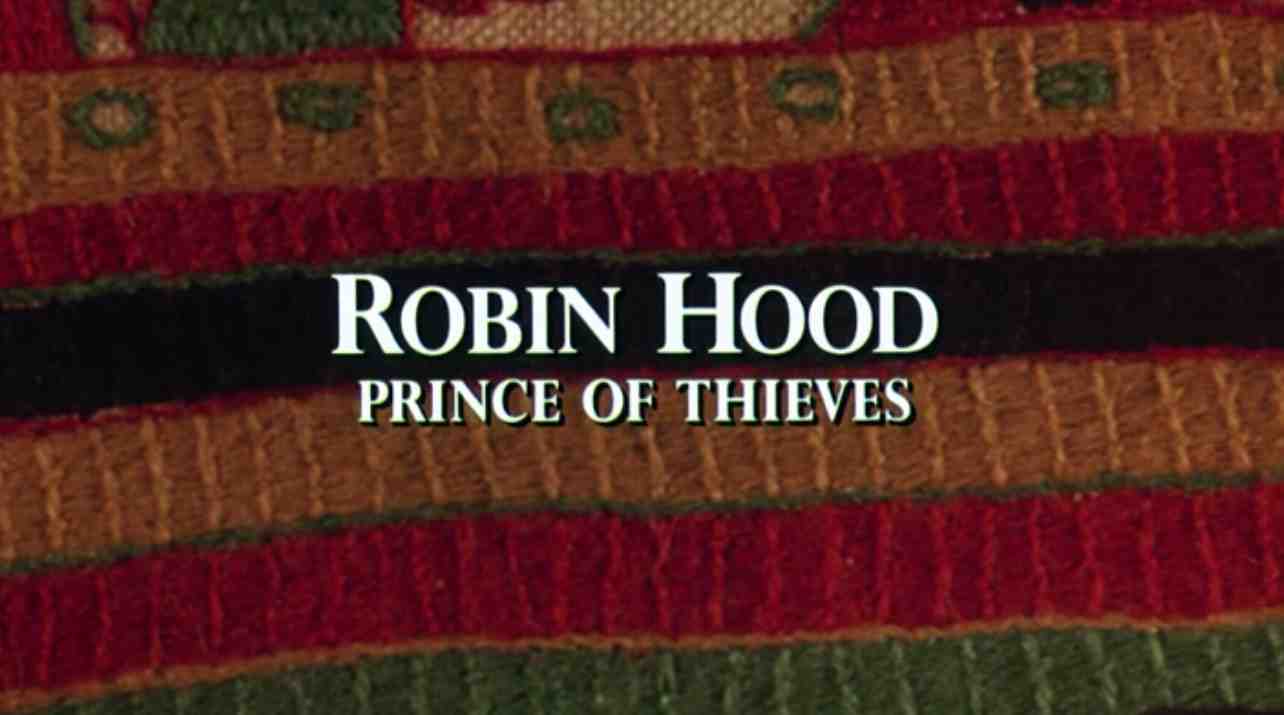
Thursday May 06, 2010
Our Vietnam Trip—Part IV: The Most Respectful Visitor to the Ho Chi Minh Mausoleum
Andy: You’re not scared, are you?
Me: [Pause] Of course.
It was Wednesday morning, the power was out at Andy and Joanie’s place, and we were talking about a xe em ride into town. Xe ems are motorcycle taxis and the idea of riding on the back of one as it weaved in and out of Hanoi traffic was a little off-putting. But Patricia was getting a ride on Andy’s bike, and three on a bike didn’t make much sense (to westerners), so it was my next-best option.
It was actually a breeze. The roads we drove on weren’t superbusy. More importantly, traffic seems a lot less dangerous when you’re part of it rather than trying to cross it. The lesson, if one example can make a lesson, is a kind of modern Buddhist koan: Be one with the traffic.
We were let off, by Andy and the xe em driver, at Ba Dinh Square, which we had visited on Sunday, not knowing it was a Sunday, and which is an oasis from the traffic. On Hung Vuong, the road that runs between the three Ho Chi Minh sites and a wide expanse of manicured grass and footpaths, traffic is blocked off for two city blocks, so the pace of life is back to a walking pace. One is less assaulted by noise and pollution. This was particularly true when we visited last Sunday, not knowing it was a Sunday, since the place was virtually deserted, but it was less true Wednesday morning at 10:00, when an anaconda-sized line, filled mostly with schoolkids, snaked from the mausoleum’s entrance down to the southern end of Hung Vuong. The mausoleum, where Ho Chi Minh’s body was interred, was what we came for, since it was only open in the mornings, but I took one look at that line and my shoulders drooped.

“Maybe we should just bag this.”
“What do you mean?” Patricia said.
“We’re never going to get in.”
“Sure we will. Look, the line’s moving quickly.”
It was. I began to walk toward the back of the line; but an armed guard, seeing me approach, directed me to the other side of the street. The only foot traffic allowed directly in front of the mausoleum was the line of visitors who had already been through security. We needed to go through security. That was also at the southern end of Hung Vuong.
While waiting in line for that, Patricia suddenly spoke up.
“Oh no!”
“What?”
“This.” She fingered her sleeveless top.
“Did you spill on it?”
“It’s sleeveless.”
“Right.” The guidebook warned that men in shorts and women in sleeveless tops were not allowed in the mausoleum. It was why I was wearing long pants in 80-degree weather with 90% humidity. “Should we bag it?”
“Noo!” Patricia. sounded like a child who might be denied a roller-coaster ride. She left and returned a minute later with a black shawl covering her shoulders.
“How much?” I asked.
“Thirty thousand. Is that a lot?”
“A buck fifty.”
She fingered it. “It’s not bad for a buck fifty.”
At the security checkpoint, her purse and my book bag went through the x-ray machine. Then I was told I had to check my book bag.
“What’s the point of putting it through the x-ray machine if I have to check it?” I asked the world.
“Just do it,” Patricia said.
A half hour after we arrived, an hour and a half before the mausoleum closed, we finally got in line. Ten people ahead of us I noticed the two Dutch girls from our Ha Long Bay trip and we had a small reunion. Just ahead of us stood a westerner who appeared to be obeying the letter of the dress code if not its spirit. He looked like a pirate. He wore a kerchief on his head, and longish, scraggly hair in back. His beard was scraggly. He was scraggly. It was as if he’d just emerged from 40 years in the jungle.
Then he began speaking to the women in front of him in fluent Vietnamese.
I hadn’t met a westerner yet who knew more than a few phrases in Vietnamese so this was an impressive display. When they were done talking and joking and laughing, I asked him how long he’d been speaking Vietnamese.
“Japanese,” he said.
“Right,” I said. Idiot! I thought. How could I not recognize Japanese?
We talked a bit. He was born in Romania, grew up in Britain, had been living in Japan for the last 40 years. When he found out we were from Seattle he talked up seeing a Stones concert there a few years earlier. “Three thousand dollars but it was totally worth it,” he said. He got animated. Our conversation was flowing. Then a white-gloved guard motioned for us to be silent. Suddenly we were at the front entrance. Another guard motioned for us to take our hands out of our pockets and put them at our sides. We did. Everyone was quiet and docile and stiff as we marched from the light and heat of the day and into the cool darkness of the stone mausoleum. We walked up a flight of stairs where it got even cooler. No one spoke. The only sound was the shuffling of our feet as we walked single file into a small room, where, on the other side of a u-shaped walkway, Ho Chi Minh lay in state, famously, or infamously, against his express wishes to be cremated. His body was small and his face was smooth. He had the familiar white goatee and white tunic. Was it impolite to stare? Was that allowed? Moot point. A second later we were outside again, blinking in the sun.
“Wow,” I said, breathing out.
“Do you think his body was real?” Patricia asked.
“That was worth doing just for the experience of doing it.”
“I don’t know if he was real.”
“Could you do that in the U.S.? Have people shut up in front of the Lincoln Memorial? Would that increase the experience or lessen it?”
Our Wednesday turned out to be a replay of our Sunday. After the mausoleum we walked across town to meet Andy (and, this time, Joanie) for lunch, then walked back across town for more sites. We were getting pretty good at walking Hanoi. At least I was getting pretty good at walking Hanoi. Patricia, in the middle of a road, with an army of vehicles barreling down on her, still had the urge to flee. She held onto my hand for comfort and direction. She wasn’t one with the traffic yet.
The advantage of walking Hanoi, and consulting, every other block, your map of Hanoi, is that, without knowing it, you’re learning something about the long, sad history of Vietnam. Our route to lunch, for example, took us down Dien Bien Phu (the site of the French defeat in 1954) to Hai Ba Trung (the three Trung sisters, who led the first revolt against the imperialist Chinese in the first century A.D.), then a right onto Quan Su. After a quick jog onto Tran Hung Dao (a grand commander who repelled two Mongol invasions in the 13th century), we walked down Tran Binh Trong (a 13th-century general who preferred death to collaboration), then took a left onto Tran Quoc Toan (yet another 13th-century marytr to the Mongols), before finally walking up the small side street of Ha Hoi and the restaurant.
The Hoa Sua School for Disadvantaged Youth is a non-profit restaurant, housed in an old French colonial-style building, complete with winding, outer stone staircase, where young Vietnamese are trained in the arts of restauranting, and which Andy was reviewing for an online publication. Patricia and I arrived first and took a table in the courtyard in the shade of several leafy trees. The place is on a quiet back street, and, after our long march, it felt cool and comfortable. I could feel myself decompress as I sipped my beer. I also felt a disconnect. Most of the customers were affluent westerners, most of the wait staff Vietnamese in crisp white shirts. Against the French colonial backdrop, it didn’t take much to imagine yourself in the 1950s or 1920s; to imagine yourself on the set of “The Quiet American.” One wondered, not for the last time, what the war had been about.
After Andy and Joanie arrived, we talked about our walk to the restaurant.
“We kept seeing these mannequins wearing, you know, hip clothes, but with the zipper of the jeans undone,” Patricia said.
Joanie nodded. “The mannequins are western. But Vietnamese jeans don’t fit western mannequins.”
“You’re kidding,” Patricia said.
“I thought it was supposed to be, like, a sexy thing,” I said.
“They just don’t fit,” Joanie said.
“So why don’t they get Vietnamese mannequins?” Patricia asked.
“Probably for the ‘cool’ factor,” Andy said. “The west is cool.” He talked about seeing a national ad campaign that used a male model who looked more American than Asian.
“Like Taipei 20 years ago,” I said, sounding like a broken record.
“So even our mannequins are fat,” Patricia said.
Our walk back, in the greater heat and humidity of the day, was a slog, weighted down, as we were, with food, beer, and a greater sense of our own massive westernness. It didn’t help that we were backtracking. We were visiting Van Mieu, The Temple of Literature, just a few blocks south of where we’d been that morning, but it was a site Patricia had read about and was determined to see. It had been dedicated 900 years ago as a place of higher learning, and like most places of higher learning it was tough to get into. The Temple encompasses several city blocks, all walled in, and we hit it in the middle of the eastern wall and headed north. Bad move. The entrance is along the southern wall. We had to walk three-quarters of the way around to get in.

After wading through a sea of chattering schoolkids, all dressed in dark pants, white shirts and red kerchiefs, who occasionally broke out their English when they saw us coming (“Hello hello hello”), we walked through the main gate. Van Mieu is long and symmetrical and divided into five courtyards. In the first two courtyards there are paths to the left and right, gateways you step through on the left and right, and ponds on the far left and right. Patricia loved it, I was nonplussed. “What was the point?” I wondered. In the center of the third courtyard there’s a man-made pond, filled with man-made crap, and a few fish seemingly gasping for breath. “What was the point?” I wondered. Then I found the point. On either side of the pond is the Temple’s main attraction: ancient stone tablets, or stelae, weathered by time, that include the results of centuries-old national exams being carried on the backs of ancient stone tortoises. The oldest date from 1442 and 1448. Fifty years before Columbus.
The fifth courtyard includes the National Academy, regarded, the Rough Guide writes, “as Vietnam’s first university, which was founded in 1076 to educate princes and high officials in Confucian doctrine.” Plus there’s a gift shop. I bought a set of postcards and (finally) Bao Ninh’s novel “The Sorrow of War,” but it was while browsing the rest of the books that I felt that disconnect again. In one hand I was holding propaganda postcards celebrating April 30, 1975, the date communist North Vietnam finally chased capitalistic American forces out of the South, and with the other I was sorting through business-oriented books with smartly dressed westerners on the covers. In Vietnamese. The less-smartly dressed Bill Gates was on another cover, “11 lo’i khuyen—danh cho the he tre cua,” while other examples of western culture were available for purchase: “Cuon Theo Chieu Gio” (“Gone with the Wind”), “Trang Non” (“New Moon”), and, thanks to Robert Downey, Jr., Sherlock Holmes. So how did we get from April 30, 1975 to “11 lo’i khuyen”? It’s as if hearts and minds are more easily won with promises of wealth and romance than with guns and bombs. Imagine.
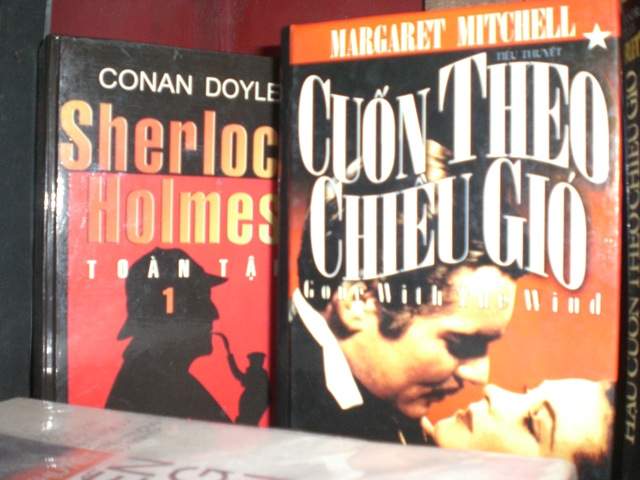
Afterwards, Patricia and I walked across Nguyen Thai Hoc (the 20th century Vietnamese revolutionary who was executed by French authorities, at the age of 28, after the Yen Bai mutiny of 1930) to the Fine Arts Museum. The Temple of Literature had been outdoors, crowded, and hot. The Fine Arts Museum was indoors, empty, and hot. A few air conditioners sputtered here and there, but the building was old, the doors open, the rooms muggy. One wondered what such conditions were doing to the artwork on the walls, some of which was quite good, and obviously influenced by whatever artistic trends were big in Europe in the early part of the 20th century. After 1954 and Dien Bien Phu, though, the themes changed from the personal and universal to, basically, Uncle Ho: in the counryside, smoking a cigarette, with kids. Sometimes all three. It was awful stuff. It didn’t even have the vibrancy of official propaganda artwork—like in the postcards I had just bought. It felt like every artistic sensibility of every painter was smothered.
The power was still out when we returned to the Engelson’s place, and so, rather than dinner at home with Andy’s friend, Matt Steinglass, we took a cab back to the main part of the city, near Hua Lo prison, to a favorite restaurant of Andy and Joanie’s, Quan An Ngon on Quan Su. It was a noisy and vibrant joint, with tons of wait staff, and reminded me of the type of two-tiered restaurant Jackie Chan, in one of his mid-‘80s films, might get into a spectacular, acrobatic fight. I would forever after refer to it as “The Jackie Chan restaurant.” Andy, poor bastard, kept trying to refer to it by its real name, but no matter how he elongated and warped his mouth, he could never get the “Ngon” right. He’d give it a go, look over at Fiona, age 7, who would quietly shake her head and correct him before going back to her drawings.
The girls had crayons and paper out, the adults were drinking ba ba ba (“333” beer), the wait staff, as many as 7-10 people, crowded around the table. Quan An Ngon has great customer service but we got extra attention less because we were westerners than because we were westerners with children. It’s difficult in Vietnam, or in Asia, for westerners to blend into the background (“Hello hello hello”), but you do cease to exist if you enter a joint behind kids. All attention is on them. Is it too much attention? At one point, two of the waitresses crouched behind Fiona’s chair and began stroking her long blonde hair. Some part of me flinched, but Fiona kept drawing while Andy and Joanie didn’t bat an eye. They trusted Fiona to object. Matilda objects. She doesn’t like the attention. Once again I admired the calm of parents. I'm havng enough trouble just getting me through life.
During dinner—a dizzying, delicious array of spicy vegetables, seafood, and meats—Joanie told us her story, or Matilda’s story, of the Ho Chi Minh mausoleum. Andy hadn’t been yet but Joanie went with her daughters and visiting relatives, and they were told, yes, the same things we were told by the guards: be quiet, arms at sides, be respectful. Matilda, age 4, listened, nodded, walked in with the others in silence. Then they all walked out in silence. Then Matilda asked a seemingly relevant question: “Where’s Ho?” She’d been so quiet and respectful she hadn’t even turned her head to see his body lying in state. You could argue that Matilda Engelson, American, age 4, was the most respectful visitor ever to the Ho Chi Minh mausoleum. She was so respectful she hadn't even seen him. He wasn't even there. Which is what he'd wanted all along.
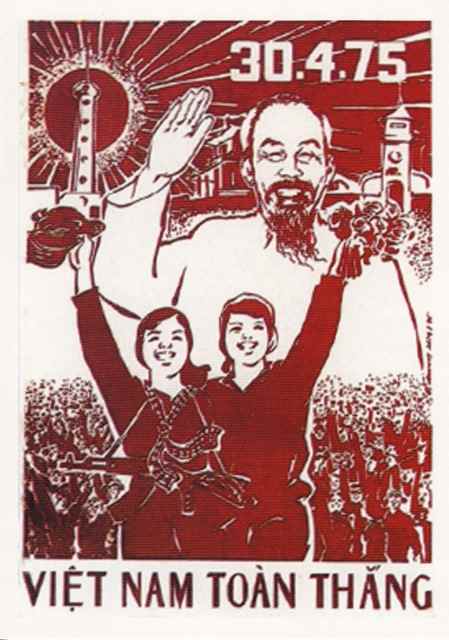

Wednesday May 05, 2010
Morons, Crooks, and the People Who Saw It Coming: Assessing Credit on the Subprime Mortgage Disaster
Here are four names to remember. There are more but these are the ones I know:
Michael Burry
Greg Lippmann
Steve Eisman
John Paulson
They're the names to trot out whenever someone—particularly a higher up at an investment bank—says, vis a vis the subprime mortgage disaster, that no one saw it coming.
No, people saw it coming. These guys saw it coming. They bet against it and made hundreds of milions. Or billions.
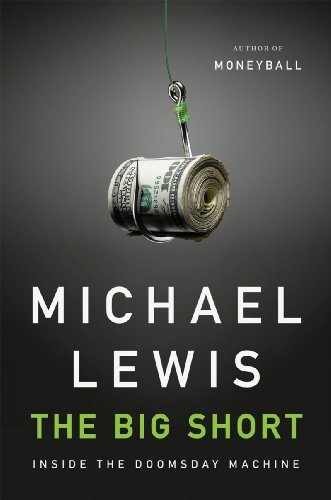 I certainly didn't see it coming. I'm an idiot when it comes to finance. I'm even more of an idiot when you get into esoteric matters like banks selling mortgages and bundling them into bonds, which are rated by agencies that aren't rating them properly, and some of these bonds, the worst of the bonds, are sometimes rebundled into new packages called collateralized debt obligations, or CDOs, that are also rated by agencies that aren't rating them properly, and then side-bets are placed on those... I mean, you lost me back at the pass. It's partly why I read Michael Lewis. He writes well enough that even I can fathom some of this stuff. Right now I'm reading "The Big Short: Inside the Doomsday Machine," about the subprime mortgage disaster.
I certainly didn't see it coming. I'm an idiot when it comes to finance. I'm even more of an idiot when you get into esoteric matters like banks selling mortgages and bundling them into bonds, which are rated by agencies that aren't rating them properly, and some of these bonds, the worst of the bonds, are sometimes rebundled into new packages called collateralized debt obligations, or CDOs, that are also rated by agencies that aren't rating them properly, and then side-bets are placed on those... I mean, you lost me back at the pass. It's partly why I read Michael Lewis. He writes well enough that even I can fathom some of this stuff. Right now I'm reading "The Big Short: Inside the Doomsday Machine," about the subprime mortgage disaster.
Man, is it depressing.
There was an article in The New York Times yesterday, Andew Ross Sorkin's column, about uber-investor Warren Buffett coming to the defense of Goldman Sachs. He said: "I don't have a problem with the Abacus transaction, and I think I understand it better than most." He probably does. I didn't even know it was called the Abacus transaction. All I know is that John Paulson helped put together...what? A bond? Securities? An instrument? Then he shorted that instrument, the Abacus instrument, and Goldman Sachs didn't tell the people who bet long that the instrument was put together in part by the guy who was shorting it; the guy on the other side of their bet.
Buffett says:
“I don’t care if John Paulson is shorting these bonds. I’m going to have no worries that he has superior knowledge. ... It’s our job to assess the credit.”
To which Sorkin chimes in: "The assets are the assets. The math either works or it doesn’t."
All of that makes sense. But it still sounds wrong. It's like finding out that the lineup of the baseball team I'm betting on was put together, not by the manager, whom I trust, but by the guy in the stands who's betting against my team, whom I don't. This behavior may not be illegal but it should be.
There's also the matter of being able to see the line-up. That lineup may not be online. It may not be posted in the dugout. The manager might not exchange it with the other manager's lineup before the game begins. Buffett calls it "assessing the credit," but according to Lewis, the bond market is opaque in a way that the stock market, which is more heavily regulated, is not. It's often hard to assess the credit. Was this particular instrument that John Paulson created for Goldman Sachs one of those that was hard to assess? I don't know. Does Warren Buffett, who understands these things better than most, have greater access to Wall Street firms and can thus assess the credit more easily than, say, a Michael Lewis, or you, or I? I don't know. These are merely my follow-up questions. The follow-up questions that Andrew Ross Sorkin didn't ask.
Let's pull back further. Are roles being blurred here? Why are investors on either end of a deal creating that deal? Why are investment banks placing bets on their own creations? Why is this allowed? Why is this still going on?
Back to Lewis' book. Page 158:
It was in Las Vegas [in Jan. 2007] that [Steve] Eisman and his associates' attitude toward the U.S. bond market hardened into something like its final shape. As Vinny put it, "That was the moment when we said, 'Holy shit, this isn't just credit. This is a fictitious Ponzi scheme.'" In Vegas the question lingering at the back of their minds ceased to be, Do these bond market people know something that we do not? It was replaced by, Do they deserve merely to be fired, or should they be put in jail? Are they delusional, or do they know what they're doing? Danny thought that the vast majority of the people in the industry were blinded by their interests and failed to see the risks they had created. Vinny, always darker, said, "There were morons and crooks, but the crooks were higher up."
That's Eisman and associates in Jan. 2007. They saw it coming. And Michael Burry? He saw it coming in 2003.
You should read Lewis' book. Burry is the most interesting character in it but Eisman is the big quote. I leave with him:
I think Alan Greenspan will go down as the worst chairman of the Federal Reserve in history. That he kept interest rates too low for too long is the least of it. I'm convinced that he knew what was happening in subprime, and he ignored it, because the consumer getting screwed was not his problem. I sort of feel sorry for him because he's a guy who is really smart who was basically wrong about everything.
Tuesday May 04, 2010
The 10th Reason to Hate 3-D
Roger Ebert gives us nine reasons “Why I Hate 3-D (And You Should, Too)” in Newsweek magazine. Here's a 10th reason from me. Maybe it's encompassed in one of the others, such as “It Adds Nothing to the Experience” or “Have You Noticed That 3-D Seems a Little Dim?,” but it seems important enough to stand alone:
It makes the movies seem SMALL.
I noticed this while watching “Up” in 3-D last year. By creating volume for the 3-D image, it seems to shrink it. The characters don't seem as big, the canvas doesn't seem as wide. It's no longer bigger than life. Maybe you need 2-D to seem bigger than life. Maybe that's what bigger than life means: two dimensions. I preferred “Up” in 2-D, when the colors, per Roger, seemed glorious, and when my imagination, per Roger, provided that third dimension.
Roger's is a good starting point to a counter-argument that no one in Hollywood will listen to. Because they have 2.7 billion reasons not to. Because they think “Avatar”'s success was built solely on 3-D, which is something they can control, rather than expert storytelling and attention to detail, which they can't.
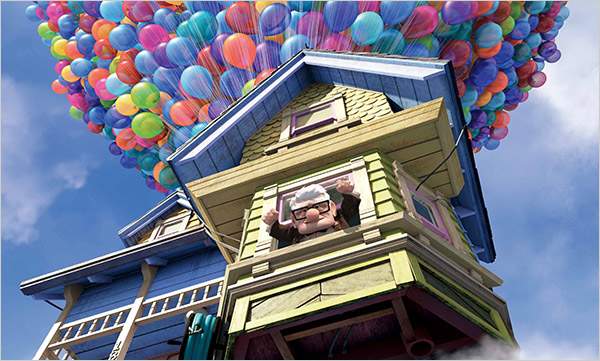
Monday May 03, 2010
Review: Robin Hood (1991-BBC)
WARNING: PIERCING SPOILERS
This one surprised me. It’s tough to make a legend like Robin Hood feel new but this one comes close for this reason: it doesn’t pretend to be legendary as it’s happening. Let’s face it, none of us really knows what we’re doing. We make up this stuff as we go, and only after the fact does a pattern (possibly) emerge. At which point we say, “Oh, I get it. This is the story.”
What’s the story, or the legend, of Robin Hood? He’s a man, a noble, who stands up to a corrupt prince and his minions during a time when the legitimate king, Richard the Lionheart, is away at the Crusades or captured in Austria. He’s the best archer in the land, and not bad with a sword, either. He’s a swashbuckler, and he and his men live in Sherwood Forest and rob from the rich and give to the poor. And they have a grand time doing it. Hell, they’re merry doing it. Oh, and there’s a girl, too, since there’s always a girl. And in the end Robin gets the girl, the bad guys get their comeuppance, and Richard is reinstalled as the one and true King of England. Sound trumpets.
 Who is Robin Hood here? He’s Sir Robert Hode, Earl of Huntingdon (a perfect Patrick Bergin), a Saxon noble in a land dominated by Norman conquerors. Which means he’s privileged and not, master and not. Sure, he doesn’t like injustice, but he doesn’t like a lot of things. He does like women and drinking, however. He relishes a fight, too. Whenever someone lands a blow he comes up smiling, eyes flashing. He also has a sense of privilege (he’s a noble, after all), and a hair-trigger temper (ditto), and he tends to get involved against his better judgment. Then he shakes his head and thinks, “Crap, how did I wind up here?” Even though here is the legendary place we know he should be. His better instincts, in other words, are telling him not to become what he famously becomes.
Who is Robin Hood here? He’s Sir Robert Hode, Earl of Huntingdon (a perfect Patrick Bergin), a Saxon noble in a land dominated by Norman conquerors. Which means he’s privileged and not, master and not. Sure, he doesn’t like injustice, but he doesn’t like a lot of things. He does like women and drinking, however. He relishes a fight, too. Whenever someone lands a blow he comes up smiling, eyes flashing. He also has a sense of privilege (he’s a noble, after all), and a hair-trigger temper (ditto), and he tends to get involved against his better judgment. Then he shakes his head and thinks, “Crap, how did I wind up here?” Even though here is the legendary place we know he should be. His better instincts, in other words, are telling him not to become what he famously becomes.
The movie begins with Norman knights, led by the Norman Sir Miles Folcanet (Jurgen Prochnow of “Das Boot” fame), hunting a man who’s been poaching on royal lands. First the man tries to take his buck with him; then he abandons it, runs, but keeps falling; then, just as the hounds are upon him, he falls at the feet of...wait for the pan up...Robin Hood! Except he’s not Robin Hood yet, he’s Robert Hode, and even as the poacher, Much, recognizes him and says, “Help me, Sir Robert,” he simply stands there. He stands there as Much is caught, admonished, and—since this is his second offense—threatened with having his eyes put out. It’s up to Robert’s friend, Will (Owen Teale), to tell him what the rest of us are thinking:
“Do something.”
Robert’s response? He rolls his eyes. Love that.
But once he confronts Folcanet he doesn’t do it in half-measures. He’s an Earl. He’s used to getting his way. And he gets pissed off when others, particularly Normans, stand in his way.
Hode: Leave him.
Falconet: Who do you think you are? This man is a poacher.
Hode: On my land. I have no objection to this man hunting on my land. He’s a useful member of our community. Who exactly are you?
Falconet: I am Sir Miles Falconet. And I am the guest of the Baron Daguerre to whom this land belongs. And certainly not to some Scottish Saxon.
But Hode is friends, too, with the Baron (Jeroen Krabbe), and in the next scene we watch them playing a board game while talking about the trial Hode will undergo the next day for confronting Falconet. Daguerre jokes, as he’s losing the board game, that he’ll have to give Sir Robert a flogging. Hode doesn’t see the humor. “You can’t do that,” he says. “I’m an Earl.” For good measure he adds, “Need I remind you that while your grandfather’s father was no more than a pirate, my great grandfather was chancellor to our King!” This pisses off Daguerre. Momentarily. He’s normally a diplomatic man, and at the trial the next day he weighs the offense and Hode’s title and recommends a public lashing: one lash. This pleases neither man but it’s Hode, with his hair-trigger temper, who’s more insistently displeased, and the number of threatened lashes keeps rising until Hode reveals the Baron’s corrupt, unnoble heritage and rails against the raping and pillaging of the Normans in general. At which point the Baron stands and decrees that Hode forfeits his title and land, and all things in his possession, and orders him shackled. Which is when Robin and Will take up arms and fight their way out to a nearby forest. I believe it’s called Sherwood.
This is not a California forest, by the way. It’s dark and cold, and as soon as Hode starts a fire with a flint it begins to rain. (“Bloody Normans,” he says.) The next day he has his legendary encounter with John Little (David Morrissey) on a log bridge over a roaring river, not a tepid stream. Hode: How are you at walking backwards?” Little: “I’ve never had to try yet, shortass.” Indeed. Hode gets knocked in and nearly drowns in the rapids. Little likes his spunk, though, and brings him and Will to a bandit/outlaw hideout, which is a dank, filthy cave, not an idyllic clearing. Much, the Miller, is there as well and Hode introduces himself, to Much’s amusement, as “Robin Hood,” since his status as an earl, even a deposed earl, would be problematic in the setting. The next morning Robin and Will are about to get kicked out again. Spunk only gets you so far. It’s one meal and off you go, Little tells them, adding, “Unless you can do something.”
Hode pauses, generally confused, and says, “I can shoot. A bit.”
This is not “The greatest archer in all the land.” This is a guy who knows he’s not bad with the bow-and-arrow but assumes others could be better. Of course when he goes up against the outlaws’ best archer, Harry (Alex Norton), the two of them aiming for a stick at 100 paces, Harry shoots his arrow right next to the stick but Hode, now Robin, to the astonishment of everyone—including, one assumes, himself—splits the freakin’ stick. There’s no feeling of inevitability here. On the contrary, you feel like Robin is telling himself: “You lucky bastard.” Equally surprising? This is the last time in the film he takes up bow and arrow.

Bergin's Robin Hood is one of the most underrated.
No, Robin reveals his true gift to the outlaws with his insider knowledge of the comings-and-goings of the rich. Told they’re staking out such-and-such a road to plunder, Robin suggests another, where he knows gold is being transported by Sir Miles Falconet. And that’s what they do. Robin leads the men on a chase to a valley where Falconet thinks he has Hode; but Robin and his men have him. In the skirmish after the trial, Will cut Falconet’s neck and Hode asks about it. “How’s your wound? Hm. It’s healing.” Then anger suddenly, astonishingly pours out of him. “But some wounds never heal. Tell that to Daguerre: some-wounds-never-heal” and he presses his knife back into Falconet’s neck and reopens the wound.
Falconet and his men are stripped and ride past Maid Marian (Uma Thurman), who had been with the initial caravan, and she and Hode, who have had several back-and-forths in the film thus far, have another. As good as the film has been to this point, the stuff with Marian is, unfortunately, just as bad. It’s like they’re trying to do “Big Sleep”-ish double entendres but it’s all cringe-worthy:
Marian: So. What are you going to do with me—tie me up?
Robin: Could be a lashing.
Marian: How many strokes?
Robin: As many as are necessary... Have you been lashed before?
Marian: I’ve never had someone make me beg them me to stop.
Robin: (smiles): Then you’ve never had a proper lashing.
Seriously? Thurman is bad in this, too. Her casting, which seems perfect, is actually one of the worst things about the movie.

Absolutely beautiful. But all wrong for the role.
So the two sides keep raising the stakes. Robin steals money? Then the Baron raises taxes to make up the difference. “That’ll make him really popular,” he says. The Baron raises taxes? Robin takes the taxes. Robin and his men save two children from hanging? The Baron burns down a village. They torture a man to death to find out where Robin is. They take everything—including a 12-year-old girl. Then they further raise the reward on Robin Hood. So what does Robin do? He gives the money back to the poor to keep them on his side. “It’s their money anyway,” he says. “Their taxes.” The response from Harry and some of the other outlaws is expected. “Give it away?” Harry says. “Are you crazy?” Thus are legends borne out of happenstance. We make this shit up as we go.
The Baron, in this version, is basically the Sheriff of Nottingham—as Folcanet is Gisbourne—but he’s not, despite the aforementioned tortures, outrightly evil. The Sheriff is normally portrayed as glowering and scheming in cahoots with Prince John, but here he has to answer to Prince John (Edward Fox). Prince John wants the money, the taxes, but the Baron doesn’t have them. John is both amused and not. “They sing ballads,” John says of the people and Robin Hood. “They see a new Saxon leader emerging.” So John leaves 40 soldiers with this incompetent Baron who let things get out of hand. Then he gets histrionic. “You will turn over every blade of grass in Barnsadle, Sherwood and Nottingham until this man and his cutthroats are brought to the gallows and disemboweled while they still breathe. I will not have my throne threatened! I will not have Saxon mark Norman! And I will have my money!”
Not much comes of this, and there’s too much subplot with Marian. She disguises herself as a boy to get close to Robin but Robin figures it out (it only takes a profile), then Harry finds out, then Harry, bastard, betrays everyone by returning Marian to the Baron and Falconet. He expects a reward but gets tortured for information. We last see him hanging eyeless in a cage outside the castle. Remember in the ’38 version when arrows pierced the chests of knights and no blood emerged? Those are stories for children.
Unfortunately it all comes down to Marian’s wedding of convenience with Folcanet, which leads Robin and his men to storm the castle during All Fool’s Day. Robin and Folcanet battle with broadswords while Will gets his big scene, convincing the Baron to lay down his arms, to join Norman and Saxon. The movie ends with the marriage of Norman (Marian) and Saxon (Robin), at which point the sun, which we haven’t seen during the film, and which will symbolize the modern British empire, finally emerges. Modern England can finally be.
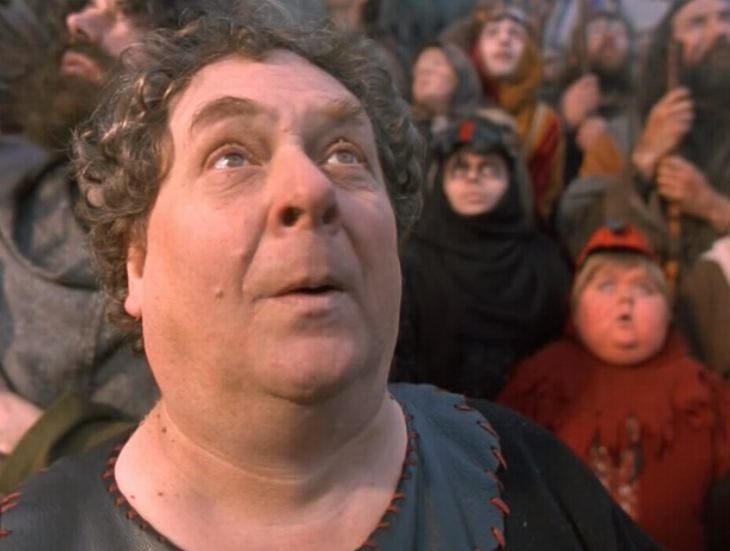
The sun, which someday will never set on the British Empire, finally shows up and warms Friar Tuck.
What a shame. The last 15 minutes of this film do a real disservice to the first 90. Prochnow overacts horribly in the last half, too.
But the first 90 are fascinating. What a great story! An occupied noble with a hair-trigger temper and a love of fighting bands with commoners and uses his insider knowledge to bring down the occupiers. It’s not the stuff of legend, but it ain’t bad.
Sunday May 02, 2010
Lancelot Links
- Video of Al Pacino speaking with Katie Couric on "60 Minutes." Do I find out anything I don't already know about Al? I guess that he was raised by a single mother and grandparents, and that his mother and grandfather died when he was relatively young, and where "Attica!" in "Dog Day Afternoon" and "Hoo-ah!" in "Scent of a Woman" come from. That's about it. It's fun listening to him but the questions are so generic, and often gossipy, that you're not learning much. I would've asked more about "The Insider", or at least one question about "The Insider," but I know I'm in the minority.
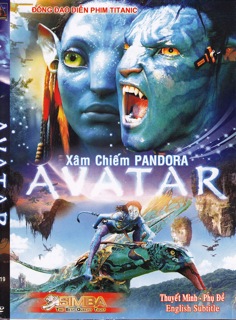 Now here's an interview. Chris Nashawaty of Entertainment Weekly talks to director James Cameron as "Avatar" comes to DVD in the U.S. (a month after I bought it in Vietnam for 50 cents). Money quote, much reprinted, on the puny DVD extras. Cameron: "There’s zero extras! There’s so few extras that you put it in, you push play, and the movie starts. There are no trailers, there’s no bullshit at the beginning that you have to endlessly go through. I have a deal with the studio and it goes like this: Any movie I make that makes over a billion dollars goes out without a bunch of crap trailers for your other movies." Hoo-ah!
Now here's an interview. Chris Nashawaty of Entertainment Weekly talks to director James Cameron as "Avatar" comes to DVD in the U.S. (a month after I bought it in Vietnam for 50 cents). Money quote, much reprinted, on the puny DVD extras. Cameron: "There’s zero extras! There’s so few extras that you put it in, you push play, and the movie starts. There are no trailers, there’s no bullshit at the beginning that you have to endlessly go through. I have a deal with the studio and it goes like this: Any movie I make that makes over a billion dollars goes out without a bunch of crap trailers for your other movies." Hoo-ah!
- A lot has already been said about the new Arizona immigration law and the demand, the Nazi-era demand, for people to show their papers, but a couple of readers on James Fallows' Atlantic site have good takes. The first reader's comments are particularly apt. If driver's licenses don't count as citizenship papers, then U.S. citizens don't really carry around citizenship papers. Put another way: Nothing defines an American more than NOT carrying around the very thing Arizona's new law demands you carry around to prove you're American. The most suspect people, then, are the people who can prove they're not suspect. Nice law. The second reader's comments have a kind of Nelsonesque "Haw-haw!" attached to them, since the right wing in this country is becoming like the very thing they've always disparaged: France. It's amusing, certainly, but here's a killjoy reminder: The last thing we want is for Latinos in this country to feel as welcome as northern Africans do in France. That's not what we're about.
- Andy Engelson in Hanoi eats some crickets, reads Saul Bellow, hoists a couple of glasses of fresh beer.
Saturday May 01, 2010
“He's Moving Like a Tremendous Machine!”
My mother and my friend Jim both love horses and horse-racing movies, so they're both happy it's Derby day, and they're both looking forward to Disney's “Secretariat,” about one of the greatest horses who ever raced.
This morning, Derby morning, I watched the “Secretariat” trailer for the first time. The movie stars Diane Lane as the horse's owner, John Malkovich as the horse's trainer, and Margo Martindale (who played the American abroad narrating her Paris adventures in horribly accented French, in Alexander Payne's sweet, melancholy vignette in “Paris, je t'aime”) as the horse's namer. Good cast. But it looks awful. How do you make drama out of a horse winning the Triple Crown by 31 lengths? (“He's moving like a tremendous machine! Secretariat by 12! Secretariat by 14 lengths at the turn!...”) You make it all about the horse's owner.
Hopefully they'll still give us Chic Anderson's great call. October release.

Secretariat by a nose.
Baseball's Active Leaders, 2023
What Trump Said When About COVID
Recent Reviews
Everything Everywhere All at Once (2022)
Black Panther: Wakanda Forever (2022)
Doctor Strange in the Multiverse of Madness (2022)
Spider-Man: No Way Home (2021)
The Cagneys
A Midsummer Night's Dream (1935)
Something to Sing About (1937)
Angels with Dirty Faces (1938)
A Lion Is In the Streets (1953)
Man of a Thousand Faces (1957)
Never Steal Anything Small (1959)
Shake Hands With the Devil (1959)







